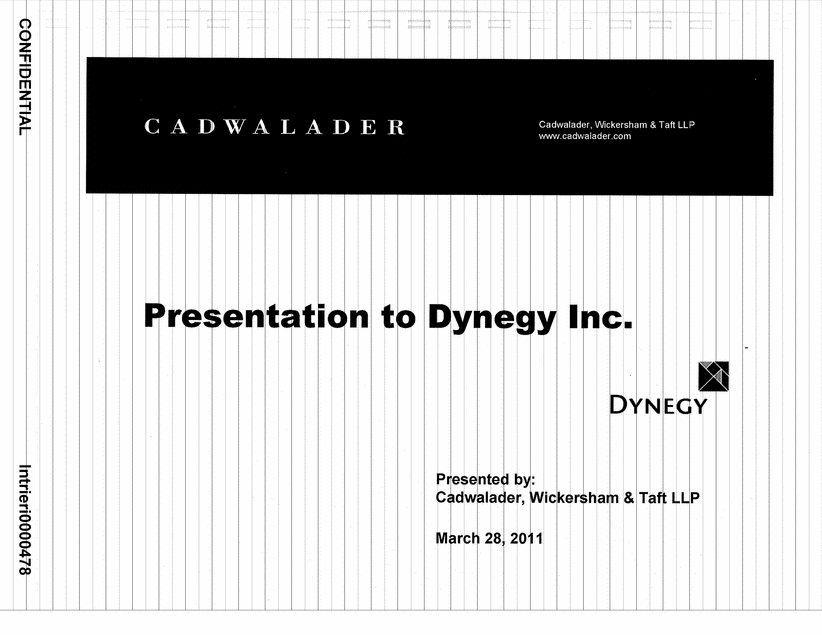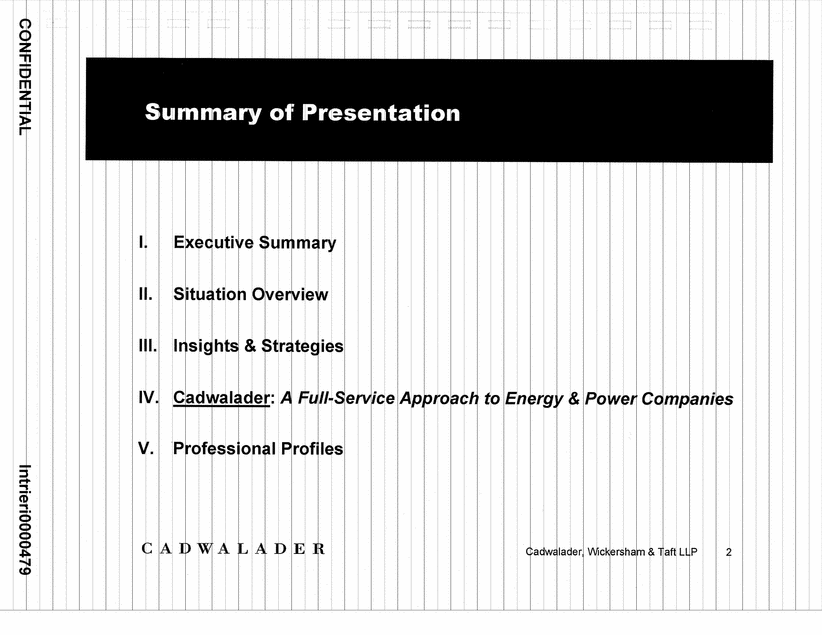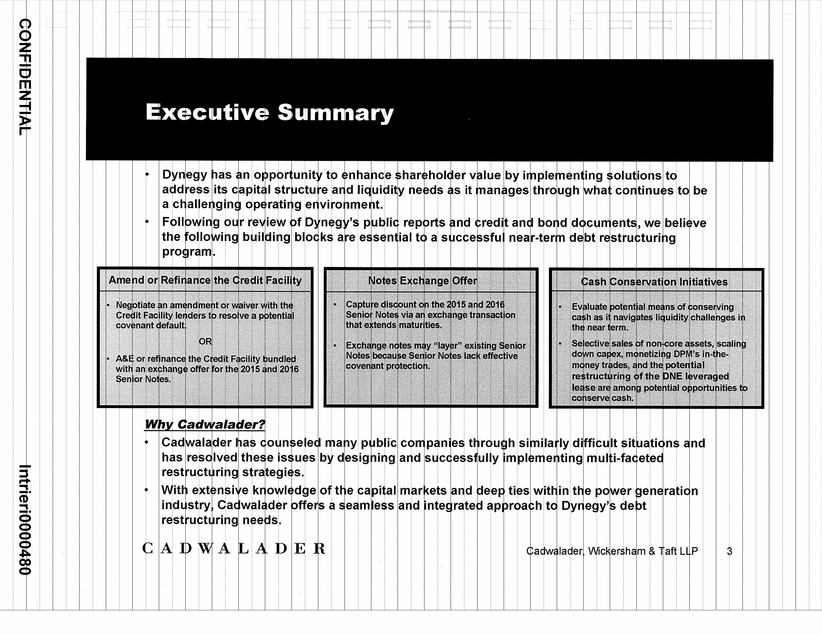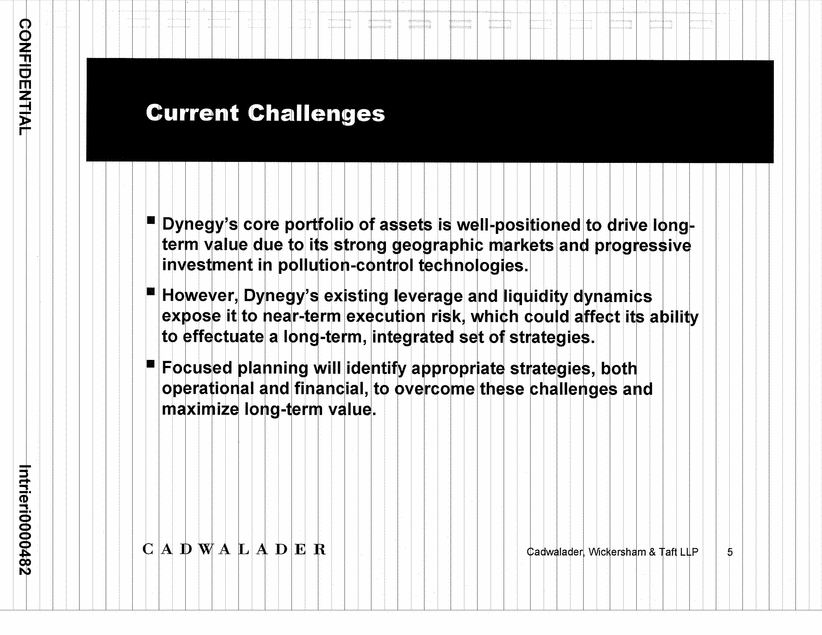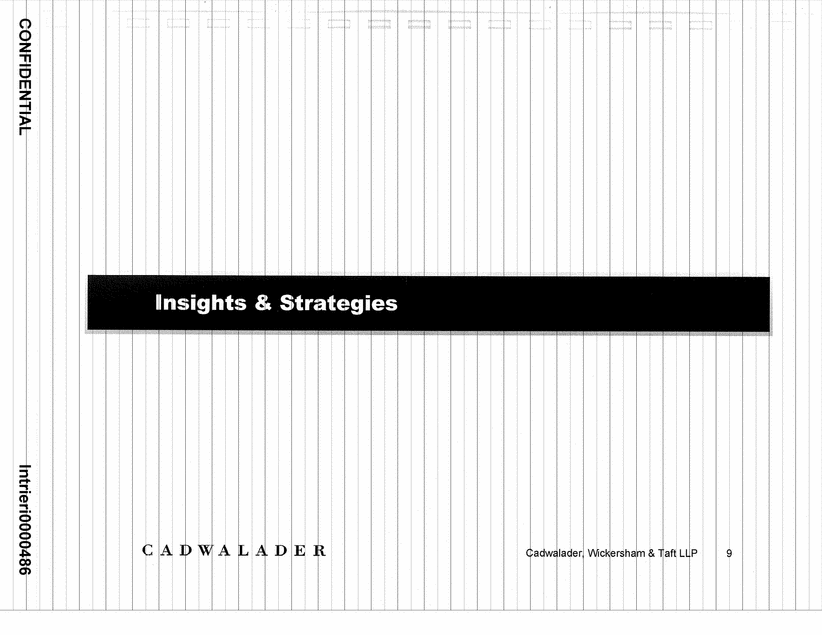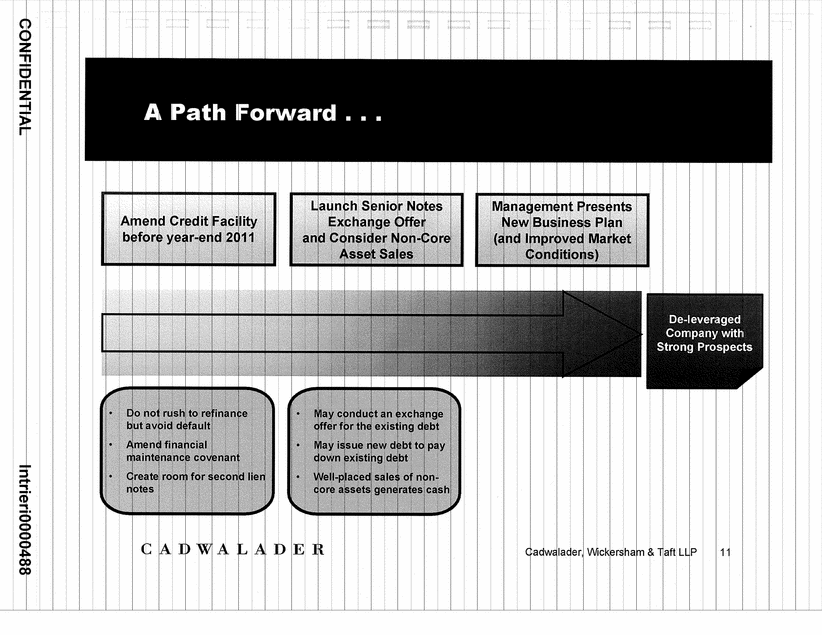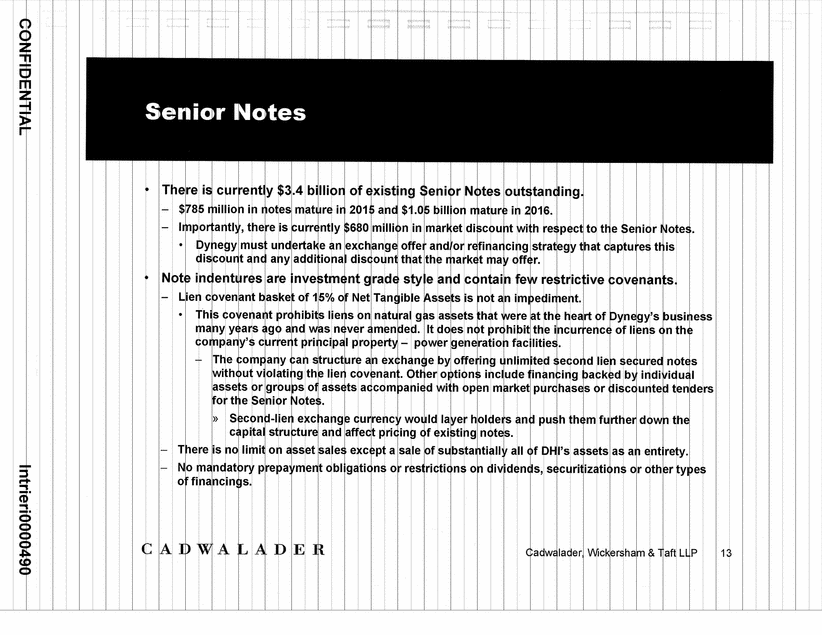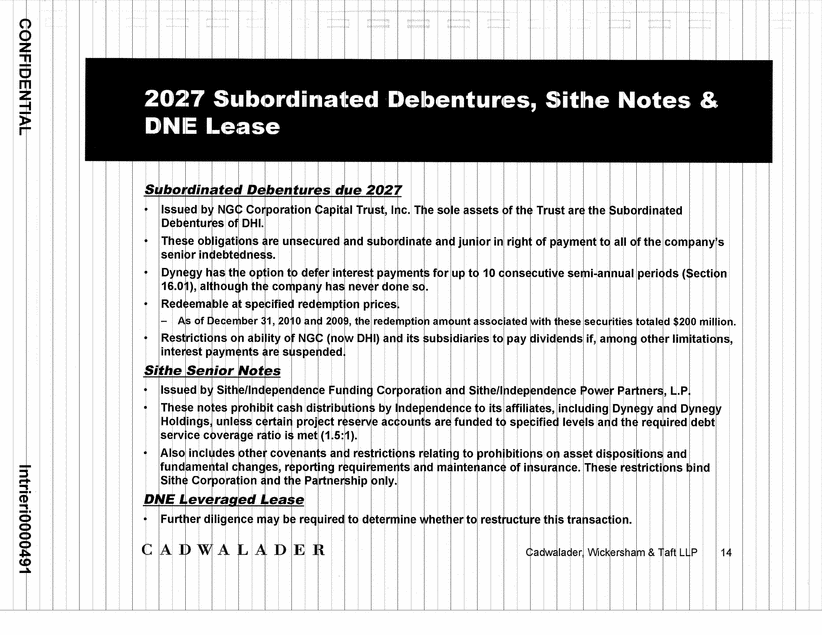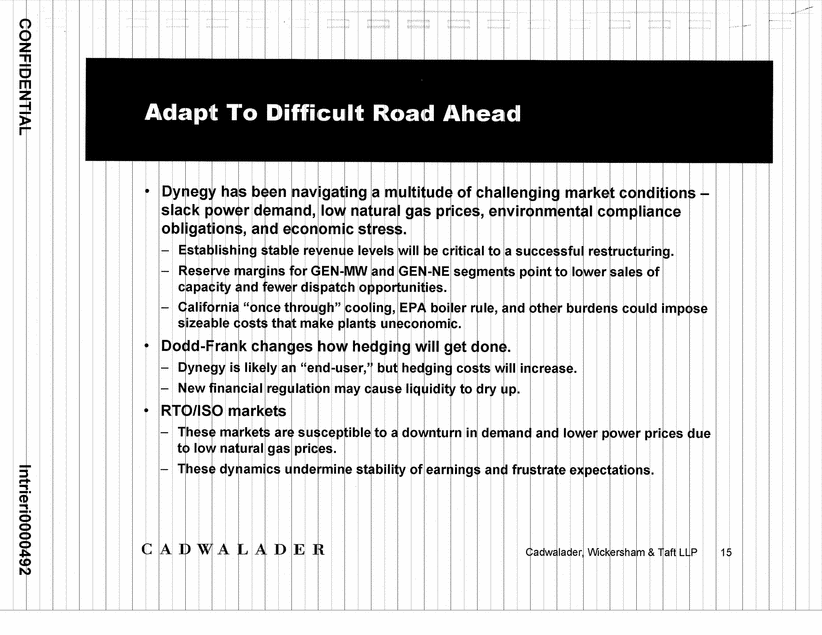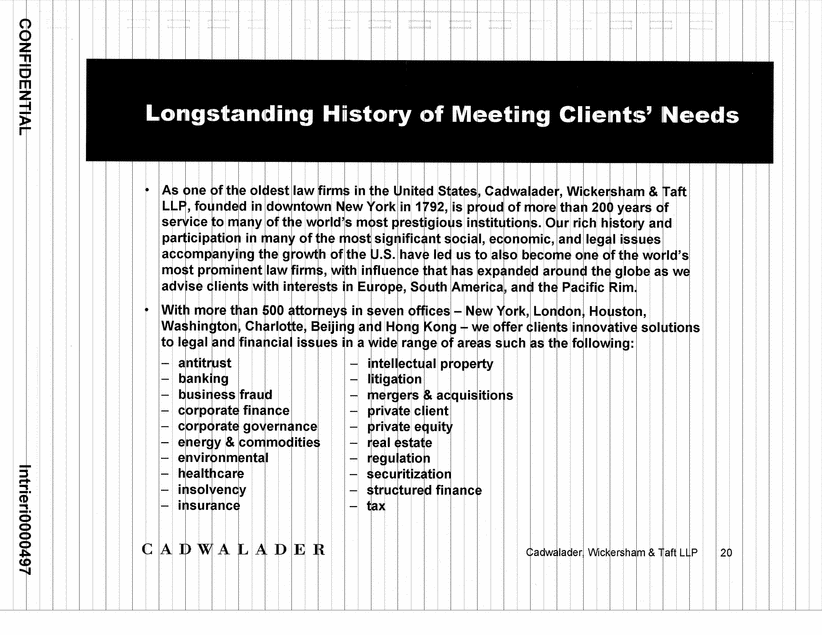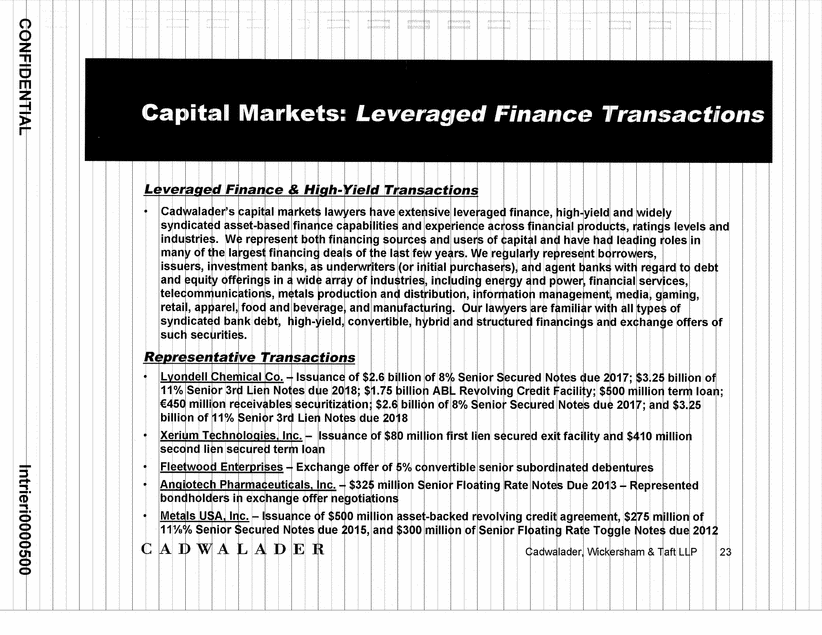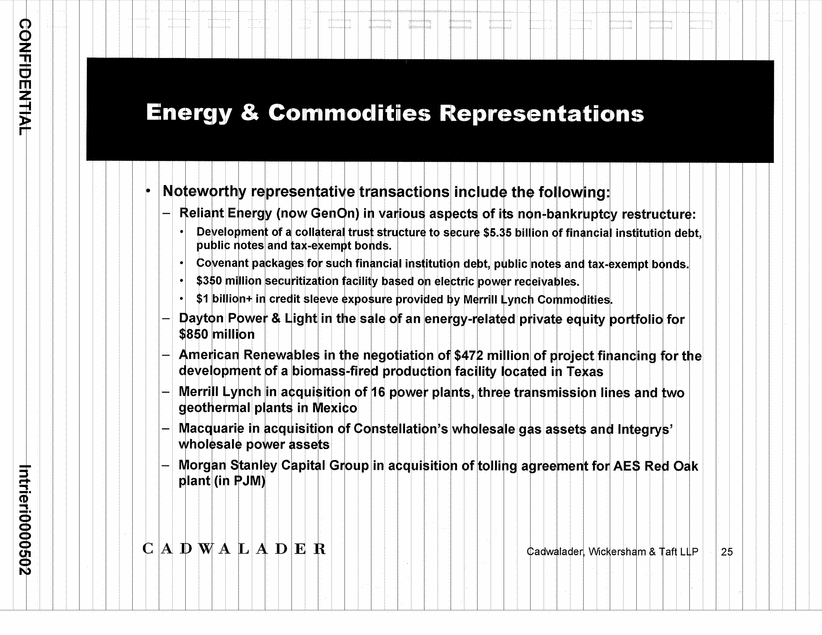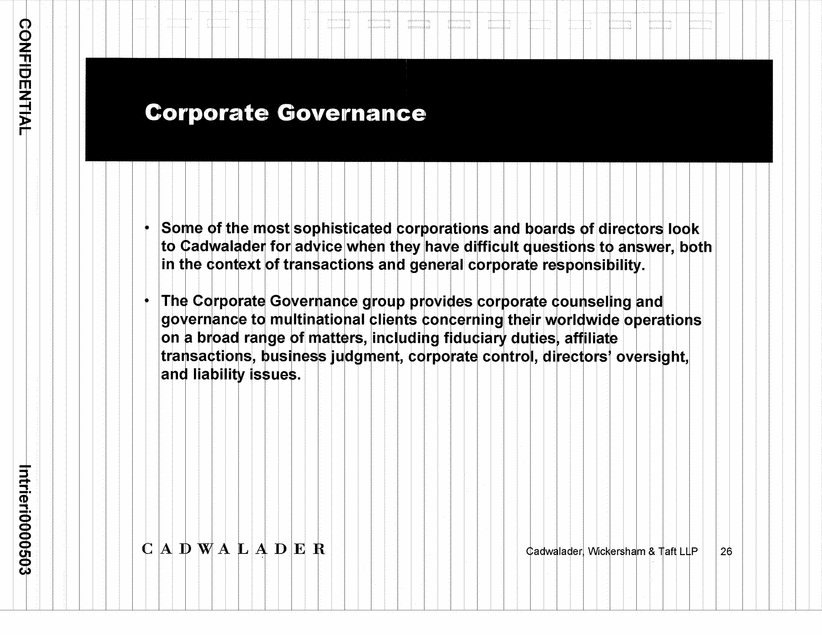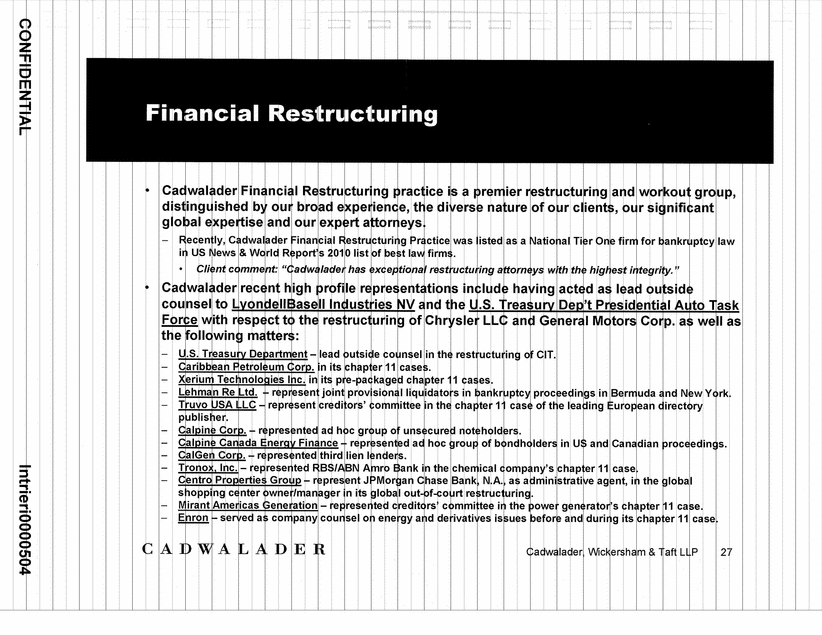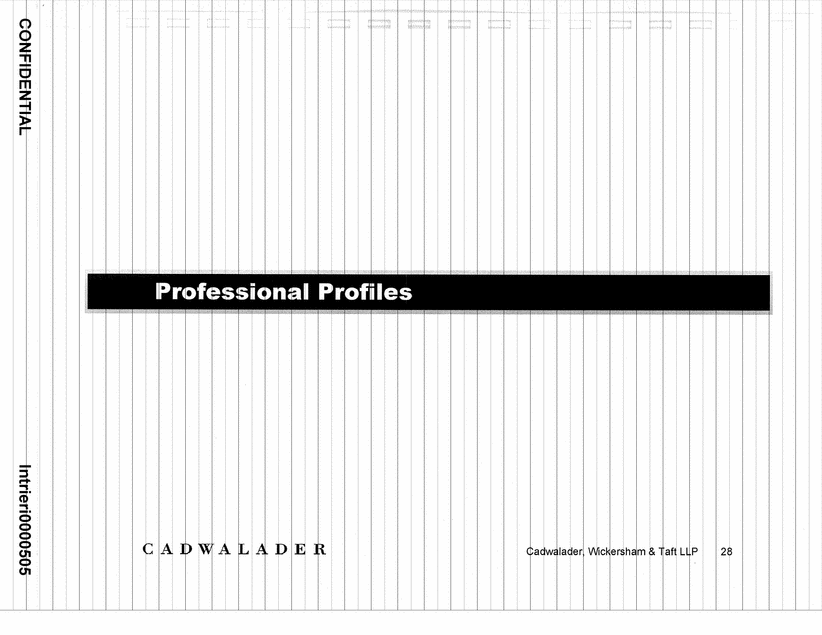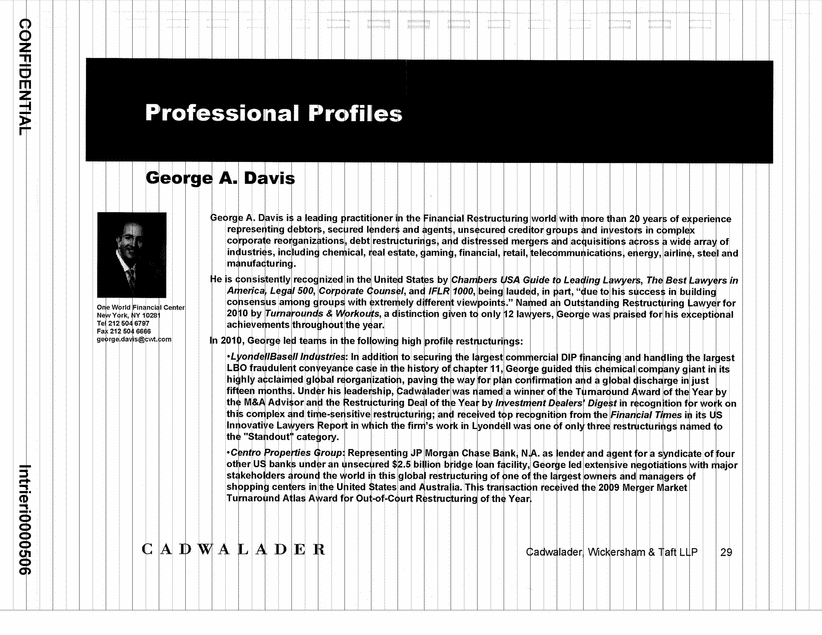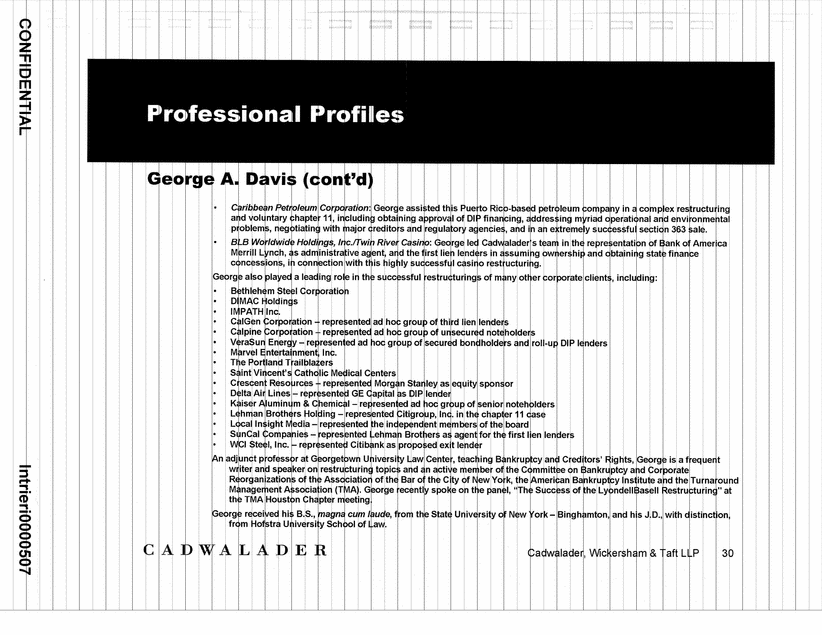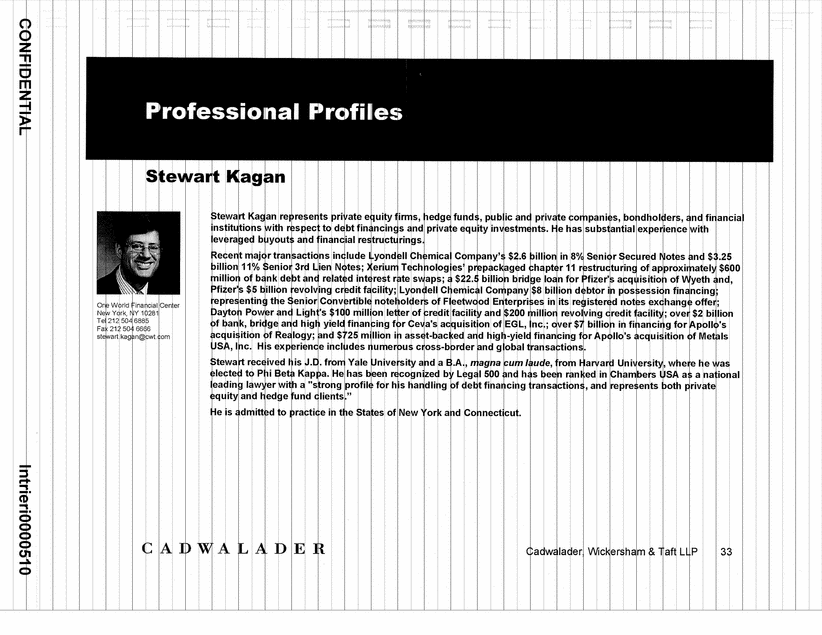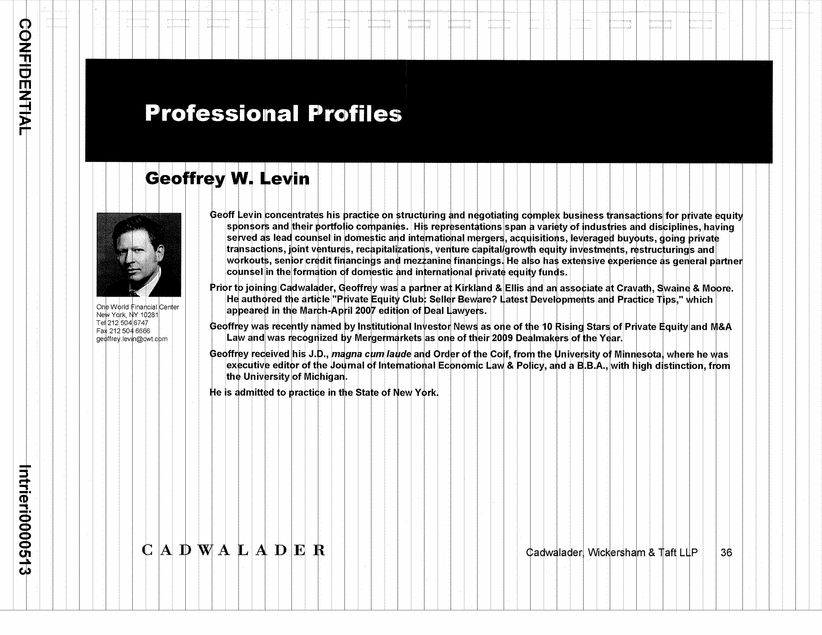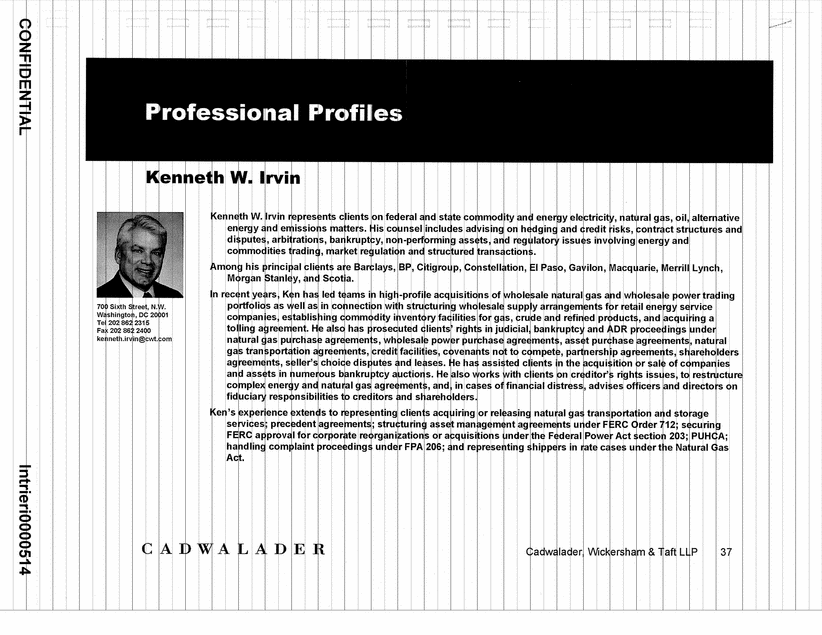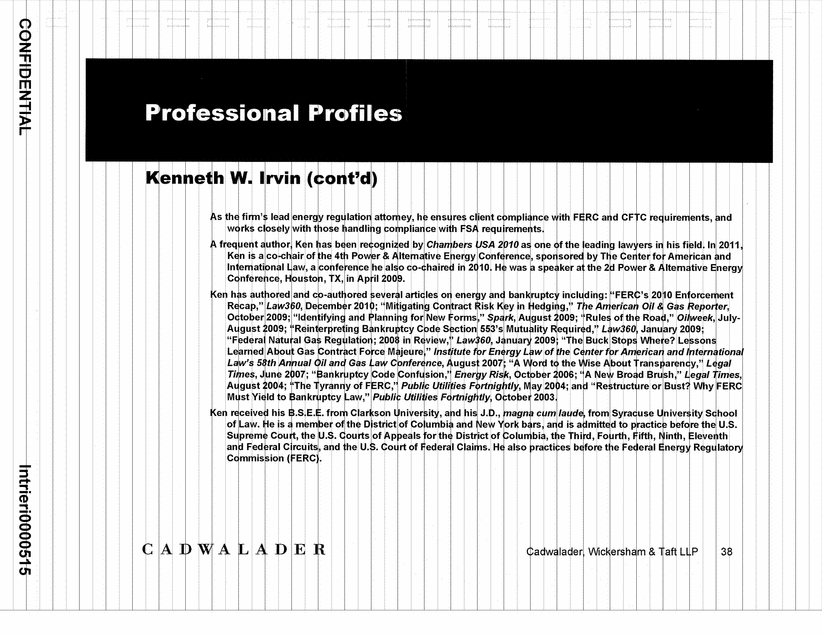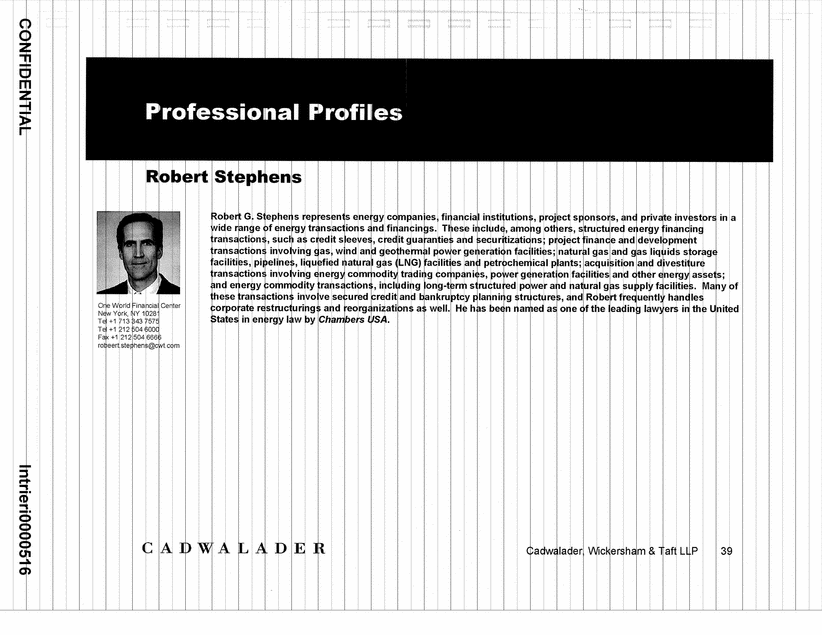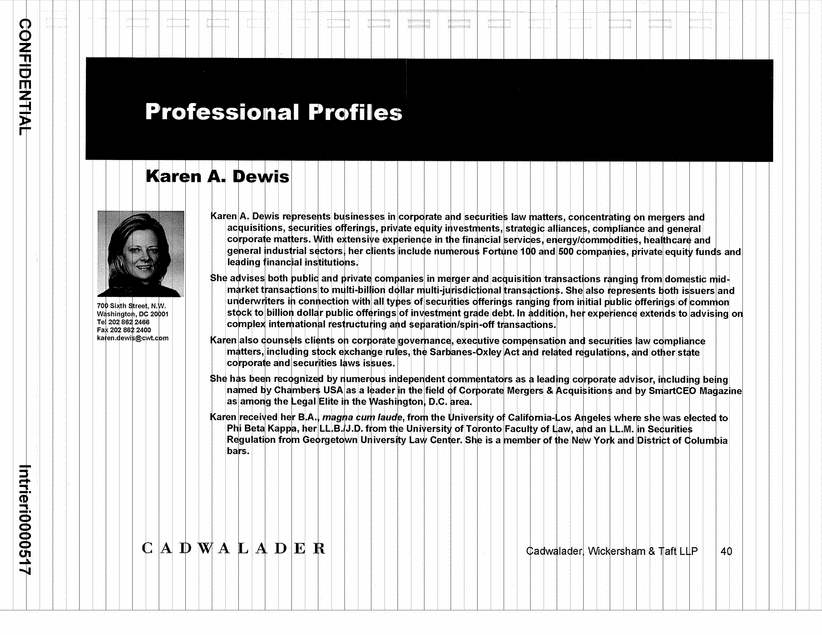Exhibit 99.2
WHITE & CASE LLP
1155 Avenue of the Americas
New York, NY 10036
(212) 819-8200
(212) 354-8113 (Fax)
Thomas E Lauria (pro hac vice)
Glenn M. Kurtz
J. Christopher Shore
Counsel to Dynegy Inc.
UNITED STATES BANKRUPTCY COURT
SOUTHERN DISTRICT OF NEW YORK
| ) | |
In re: | ) | Chapter 11 |
| ) | |
DYNEGY HOLDINGS, LLC, et al., | ) | Case No. 11- 38111 (CGM) |
| ) | |
| ) | Jointly Administered |
Debtors. | ) | |
| ) | Re: Docket No. 490 |
| ) | |
PRELIMINARY RESPONSE OF DYNEGY INC. TO
THE REPORT OF SUSHEEL KIRPALANI, EXAMINER
TABLE OF CONTENTS
PRELIMINARY STATEMENT | 1 |
STATEMENT OF FACTS | 7 |
A. | Difficulties Facing DH | 8 |
B. | The Refinancing | 9 |
C. | The Possibility Of Just Borrowing More And Waiting | 10 |
D. | The Exchange Offer | 11 |
E. | The Path Of The Restructuring Was Obvious And Proper To Everyone, Including The Counsel Challenging The Restructuring | 12 |
RESPONSE | 14 |
| I. | THE EXAMINER’S REPORT IMPROPERLY ASSUMES INSOLVENCY | 15 |
| II. | THE REPORT’S CONCLUSIONS REGARDING FIDUCIARY DUTIES ARE PLAINLY INCORRECT | 19 |
A. | All Findings Of Fiduciary Misconduct Are Improperly Premised On DH’s Insolvency As Of September 1, 2011 | 20 |
B. | The Report Omits Any Discussion Of The Key Case On The Standard To Be Applied to Actions Of The DH Board Of Managers — The Roselink Case — And The Business Judgment Rule | 21 |
C. | DH Managers Did Not Owe Fiduciary Duties To DH Creditors | 28 |
D. | DH’s LLC Agreement Shields DH’s Managers From The Breach Of Fiduciary Claims Asserted By The Examiner | 31 |
E. | DI And Its Directors Did Not Owe Fiduciary Duties To DH Or Its Creditors And There Is Absolutely No Basis For Contending That Board Did Anything Inappropriate | 33 |
F. | The Report’s Conclusions On Corporate Opportunity Are Plainly Flawed | 35 |
G. | There Are No Damages For Any Alleged Breach Of Individual’s Duties | 36 |
| III. | THE EXAMINER’S CONCLUSION OF A FRAUDULENT TRANSFER IS INCORRECT | 37 |
A. | DH Creditors, And Thus DH Itself, Lack Standing To Pursue A Fraudulent Transfer Claim | 37 |
B. | The Examiner Cannot Avoid The Law By Assuming An Ability To Pierce The Corporate Veil | 39 |
C. | According To The Examiner’s Own Findings, There Was No Intent To Hinder Or Delay | 43 |
D. | DI Provided Reasonably Equivalent Value | 48 |
| 1. | The Value Of CoalCo Was Overstated | 48 |
| 2. | The Zolfo “Valuation” Of The Undertaking Is Understated | 49 |
CONCLUSION | 52 |
| | | | | |
i
TABLE OF AUTHORITIES
| Page |
CASES |
| |
Anadarko Petroleum Corp. v. Panhandle Eastern Corp.
545 A .2d 1171 (Del. 1988) | 34 |
| |
Aronson v. Lewis
473 A.2d 805 (Del. 1984) | 22 |
| |
ASARCO LLC v. Am. Mining Corp.
396 B.R. 278 (S.D. Tex. 2008) | 34 |
| |
Auriga Capital Corp. v. Gatz Props., LLC
2012 Del. Ch. LEXIS (Del. Ch. Jan 27, 2012) | 32 |
| |
Barrett v. Commonwealth Fed. Sav. & Loan Ass’n
939 F.2d 20 (3d Cir. 1991) | 48 |
| |
Blair v. Infineon Techs. AG
720 F. Supp. 2d 462 (D. Del 2010) | 42 |
| |
Brehm v. Eisner
746 A.2d 244 (Del. 2000) | 22 |
| |
Case Fin., Inc. v. Alden
C.A. No. 1184-VCP, 2009 WL 2581873 (Del. Ch. Aug. 21, 2009) | 41 |
| |
Cede & Co. v. Technicolor, Inc.
634 A.2d 345 (Del. 1993) | 22 |
| |
Citicorp Venture Capital, Ltd. v. Committee of Creditors Holding Unsecured Claims
160 F.3d 982 (3d Cir. 1998) | 35 |
| |
CML V, LLC v. Bax
28 A.3d 1037 (Del. 2010) | 28, 29, 32 |
| |
CNL-AB LLC v. E. Prop. Fund I SPE (MS Ref) LLC
C.A. No. 6137-VCP, 2011 WL 353529 (Del. Ch. Jan. 28, 2011) | 28, 29 |
| |
Day v. Quotron Systems, Inc.
Civ. A. No. 8502, 1989 WL 150773 (Del. Ch. Nov. 20, 1989) | 19, 21 |
| |
Eberhard v. Marcu
530 F.3d 122 (2d Cir. 2008) | 37 |
ii
Equity Corp. v. Milton
221 A.2d 494 (Del. 1966) | 35 |
| |
EWI Worldwide, Inc. v. Lifestyle Retail Partners, LLC
No. 295167, 2011 WL 184079 (Mich. App. Jan. 20, 2011) | 29 |
| |
Fliegler v. Lawrence
361 A.2d 218 (Del. 1976) | 35 |
| |
Forsythe v. ESC Fund Management Co. (U.S.), Inc.
CA. No. 1081-VCL, 2007 WL 2982247 (Del. Ch. Oct. 9, 2007) | 40 |
| |
Gantler v. Stephens
965 A.2d 695 (Del. 2009) | 22 |
| |
Gen. Video Corp. v. Kertesz
C.A. No. 1922-VCL, 2008 WL 5247120 (Del. Ch. Dec. 17, 2008) | 35 |
| |
Geren v. Quantum Chemical Corp.
832 F. Supp. 728 (S.D.N.Y. 1993) | 42 |
| |
Grace v. Bank Leumi Trust Co. of NY
443 F.3d 180 (2d Cir. 2006) | 42 |
| |
In re AppliedTheory Corp.
323 B.R. 838 (Bankr. S.D.N.Y. 2005) | 49 |
| |
In re BankAtlantic Bancorp, Inc. Litig.
C.A. No. 7068-VCL, 2012 WL 621478 (Del. Feb. 27, 2012) | 30 |
| |
In re Bernard Techs., Inc.
398 B.R. 526 (Bankr. D. Del. 2008) | 38 |
| |
In re Best Prods. Co., Inc.
168 B.R. 35 (Bankr. S.D.N.Y. 1994) | 15 |
| |
In re BH S & B Holdings
420 B.R. 112 (Bankr. S.D.N.Y. 2009) | 40, 41 |
| |
In re Bossart
No. 05-34105-H4-7, 2007 WL 4561300 (Bankr. S.D. Tex. Dec. 21, 2007) | 50 |
| |
In re Braus
248 F. 55 (2d Cir. 1917) | 46 |
| |
In re Brooke Corp.
Bankr. No. 08-22786, 2012 WL 366542 (Bankr. D. Kan. Feb. 2, 2012) | 47 |
iii
In re Denison
292 B.R. 150 (E.D. Mich. 2003) | 50 |
| |
In re Dolata
306 B.R. 97 (Bankr. W.D. Pa. 2004) | 42 |
| |
In re Dreier LLP
452 B.R. 391 (Bankr. S.D.N.Y. 2011) | 43 |
| |
In re EBI I, Inc.
380 B.R. 348 (Bankr. D. Del. 2008) | 18 |
| |
In re Eubanks
444 B.R. 415 (Bankr. E.D. Ark. 2010) | 46 |
| |
In re Extended Stay Inc.
No. 09-13764 (Bankr. S.D.N.Y. Mar. 12, 2010) | 15 |
| |
In re Image Worldwide, LTD.
139 F.3d 574 (7th Cir. 1998) | 51 |
| |
In re Iridium Operating LLC
373 B.R. 283 (Bankr. S.D.N.Y. 2007) | 16, 18 |
| |
In re J.P. Stevens & Co., Inc.
542 A.2d 770 (Del. 1988) | 22 |
| |
In re Kaplan Breslaw Ash, LLC
264 B.R. 309 (Bankr. S.D.N.Y. 2001) | 49 |
| |
In re Midway Games, Inc.
428 B.R. 303, 313-15 (Bankr. D. Del. 2010) | 21, 32 |
| |
In re Morton Shoe Cos., Inc.
24 B.R. 1003 (Bankr. D. Mass. 1982) | 50 |
| |
In re Old Carco LLC
No. 11 Civ. 5039 (DLC), 2011 WL 5865193 (S.D.N.Y. Nov. 22, 2011) | 51 |
| |
In re Parkway Calabasas Ltd.
89 B.R. 832 (Bankr. C.D. Cal. 1988) | 43 |
| |
In re Pied Piper Casual, Inc.
40 B.R. 723 (S.D.N.Y. 1984) | 15 |
| |
In re Prichard
361 B.R. 11 (Bankr. D. Mass. 2007) | 46 |
iv
In re PWS Holding Corp.
228 F.3d 224 (3d Cir. 2000) | 15 |
| |
In re Regency Holdings (Cayman), Inc.
216 B.R. 371 (Bankr. S.D.N.Y. 1998) | 38 |
| |
In re Singh
Bankr. No. 02-41704 (DHS), 2007 WL 2917235 (Bankr. D.N.J. Oct. 4, 2007) | 27 |
| |
In re Teleglobe Commc’ns Corp.
392 B.R. 561 (D. Del. 2008) | 18 |
| |
In re Teleglobe Commc’ns Corp.
493 F.3d 345 (3d Cir. 2007) | 34 |
| |
In re Ticketplanet.com
313 B.R. 46 (Bankr. S.D.N.Y. 2004) | 41 |
| |
In re Tribune Co.
No. 08-13141 (KJC), 2011 WL 5142420 (Bankr. D. Del. Oct. 31, 2011) | 15 |
| |
In re Tronox Inc.
429 B.R. 73 (Bankr. S.D.N.Y. 2010) | 42 |
| |
In re Zerbo
397 B.R. 642 (Bankr. E.D.N.Y. 2008) | 15 |
| |
Irwin & Leighton, Inc. v. W.M. Anderson Co.
532 A.2d 983 (Del. Ch. 1987) | 40 |
| |
Kashfi v. Phibro-Salomon, Inc.
628 F. Supp. 727 (S.D.N.Y. 1986) | 40 |
| |
Kelly v. Blum
C.A. No. 4516-VCP, 2010 WL 629850 (Del. Ch. Feb. 24, 2010) | 32 |
| |
Kipperman v. Onex Corp.
411 B.R. 805 (N.D. Ga. 2009) | 18 |
| |
L. L. Ridgway Co. v. Marks
146 So. 2d 61 (La. App. 1962) | 29 |
| |
Lippe v. Bairnco Corp.
249 F. Supp. 2d 357 (S.D.N.Y. 2003) | 19 |
| |
Martes v. USLIFE Corp.
927 F. Supp. 146 (S.D.N.Y. 1996) | 37 |
v
MC Asset Recovery, LLC v. Southern Co.
C.A. No. 06-CV-0417-BBM, 2006 WL 5112612 (N.D. Ga. Dec. 11, 2006) | 34 |
| |
Mellon Bank, N.A. v. Metro Commc’ns, Inc.
945 F.2d 635 (3d Cir. 1991) | 51 |
| |
Mobil Oil Corp. v. Linear Films, Inc.
718 F. Supp. 260 (D. Del. 1989) | 40 |
| |
N. Am. Catholic Programming Found., Inc. v. Gheewalla
930 A.2d 92 (Del. 2007) | passim |
| |
Nemec v. Shrader
991 A.2d 1120 (Del. 2010) | 30 |
| |
Offshore (Cayman) LLC v. Kenetech Corp.
No. 16362NC, 1999 WL 893575 (Del. Ch. Oct. 13, 1999) | 35 |
| |
Paramount Commc’ns, Inc. v. QVC Network Inc.
637 A.2d 34 (Del. 1994) | 24 |
| |
Parnes v. Bally Entm’t Corp.
722 A.2d 1243 (Del. 1999) | 22, 23 |
| |
Reserves Mgmt. Corp. v. 30 Lots, LLC
C.A. No. 08C-08-010 JTV, 2009 WL 4652991 (Del. Nov. 30, 2009) | 37 |
| |
Revlon Inc. v. MacAndrews & Forbes Holdings Inc.
506 A.2d 173 (Del. 1986) | 21 |
| |
Rixon Inc. v. Racal-Milgo, Inc.
551 F. Supp. 163 (D. Del. 1982) | 40 |
| |
Roselink Investors, LLC v. Shenkman
386 F. Supp. 2d 209 (S.D.N.Y. 2004) | passim |
| |
Roseton OL, LLC v. Dynegy Holdings Inc.
C.A. No. 6689-VCP, 2011 WL 3275965 (Del. Ch. July 29, 2011) | 38, 39 |
| |
Shandler v. DLJ Merch. Banking, Inc.
C.A. No. 4797-VCS, 2010 Del. Ch. LEXIS 154 (Del. Ch. Jul. 26, 2010) | 34 |
| |
Thorpe v. Cerbco, Inc.
676 A.2d 436 (Del. 1996) | 35 |
| |
Trenwick Am. Litig. Trust v. Ernst & Young, L.L.P.
906 A.2d 168 (Del. Ch. 2006) | passim |
vi
VFB LLC v. Campbell Soup Co.
482 F.3d 624 (3d Cir. 2007) | 16, 17, 48, 49 |
| |
VGS, Inc. v. Castiel
No. C.A. 17995, 2003 WL 723285 (Del. Ch. Feb. 28, 2003) | 29 |
| |
Vichi v. Koninklijke Philips Elecs. N.V., L.G.
No. 2578-VCP, 2009 WL 4345724 (Del. Ch. Dec. 1, 2009) | 29 |
| |
Wallace v. Wood
752 A.2d 1175 (Del. Ch. 1999) | 40 |
| |
Wood v. Baum
953 A.2d 136 (Del. 2008) | 32 |
| | |
STATUTES AND RULES
8 Del. C. § 102(b)(7) | 32, 33 |
| |
8 Del. C § 141(b) | 27 |
| |
8 Del. C § 141(f) | 27 |
| |
11 U.S.C. § 544 | 37 |
| |
11 U.S.C.§ 548 | 49 |
| |
11 U.S.C.§ 550(a) | 42 |
vii
Dynegy Inc. (“DI” or the “Company”), by and though its undersigned counsel, hereby submits this Preliminary Response (the “Response”) to the Report of Susheel Kirpalani (the “Examiner”) [Docket No. 490] (the “Report”).(1) In support of the Response, the Company respectfully states as follows:
PRELIMINARY STATEMENT
The Company is deeply troubled and disappointed by the fact that the conclusions published by the Examiner in his Report are based on numerous misstatements or incomplete statements of fact, the misapplication of blackletter law and the inexplicable omission of certain material facts and governing law relevant to its conclusions.(2) Importantly, the Report attacks and impugns the integrity of numerous individuals who have careers and reputations — all of which have been inappropriately put at jeopardy — on the basis of key assumptions made by the Examiner that conflict directly with the facts known to the boards of the Company and of Dynegy Holdings, LLC (“DH”) at the relevant time. The Company is concerned that the parties and the Court not form conclusions about the Company and its personnel before they have had the opportunity to vindicate their actions from what is as an unfair attack.
For all its disclosure about the exhaustiveness of the Examiner’s process, the Report reveals little that was not already known publicly about the Company’s prepetition restructuring transactions. Remarkably, the entire investigation, which devoted thousands of hours to the
(1) Nothing contained in the Response is believed to be subject to the attorney-client privilege, work product doctrine, or any other applicable privilege or protection. However, in the event the Response includes any information protected by the attorney-client privilege, work product doctrine, or any other applicable privilege or protection, such inclusion was inadvertent and is not a waiver of any claim of privilege or protection by DI or DH.
(2) The Company is currently in the process of carefully reviewing and understanding the pleading, reading the authorities cited, analyzing the valuation and other financial materials relied upon therein, reviewing notes of interviews where recollections may differ and gathering documents and testimony omitted from the analysis presented. The Company fully intends to address each of the material facts and conclusions of the Report to the extent that an actual justiciable controversy arises that requires an evidentiary hearing. This Response is not intended to present the Company’s entire response to the Report or constitute a waiver of any of the Company’s rights or privileges, all of which are reserved, nor is it intended to express the legal positions of any person or entity other than the Company.
1
investigation of non-Debtors,(3) resulted in either a finding of no wrongdoing by the non-Debtors or a theory of liability that is entirely dependent on unsubstantiated assumptions, unsustainable findings of wrongdoing by individuals at DH, and novel (and incorrect) extensions (or disregard) of law. In stark contrast, the Report’s conclusions about DH, its senior management and its board of managers, including the key findings regarding purported duty of care and duty of loyalty violations, are based on fewer than eight hours of interviews conducted over only two days. Those interviews — of Bob Flexon, Kevin Howell and Clint Freeland — were administered by a panel of the Examiner’s lawyers and financial advisors without any transcription. During these separate sessions, the panel tended to ask closed-ended, imprecise, and often leading questions, without providing any meaningful opportunity for the witnesses to provide explanation, other than through a parting offer that they could disclose “anything else the Examiner should know.” That process may have resulted in some nicely packaged quotes for the Report, but it hardly served to uncover the truth or present a complete picture of the actions that form the core of the Report.
For example, the Report makes repeated and emphatic references to an interview statement by the Company’s CEO, Robert Flexon, that he believed DH was “insolvent.”(4) (Report at 80, 112, 146) That characterization is at best incomplete, and at worst misleading. If the examination process had been structured to develop facts, one would have expected the examining panel to have asked why he thought that and what analysis, if any, he was relying on.
(3) Although the Report is characterized as being based on an examination of “the Debtors,” in fact, substantially all of the Examiner’s focus was devoted to an investigation of non-Debtor parties. Every member of the Dynegy board was deposed, and the key legal and financial advisors were all either interviewed or deposed. The lenders to non-Debtor entities were subjected to document requests and depositions as were other consultants to the Company.
(4) In fact, Mr. Flexon’s statement was made regarding his belief as of the time he joined the Dynegy Board on June 15, 2011 — not as of September 1, 2011, when the CoalCo transfer occurred. In two places, the Examiner included the correct temporal reference — June 15. (Report at 80, 112) In the third reference (Report at 146), the Examiner drops the temporal limitation, and incorrectly presents Mr. Flexon’s view in a way that could be construed to be his generally held position, including on September 1, 2011.
2
Instead, the panel’s examination simply stopped once a useful, pithy quote was uttered, a result which is only made more troubling by the Examiner’s failure to revisit Mr. Flexon’s statement after every other person interviewed or deposed in the investigation one way or another expressed the view — supported by specified facts and circumstances — that DH was not insolvent during the relevant period. Had the panel asked Mr. Flexon why he thought DH was “insolvent,” the Examiner would have learned that his statement was based on the fact that, when he joined the Company’s board in mid-June, the Company’s subsidiaries were in danger of an imminent default under their senior secured working capital facility — an event which would have rendered the enterprise immediately unable to pay its expenses. Had the Examiner gone on to ask Mr. Flexon his view after the senior secured credit facility had been refinanced on August 5, he would have learned that Mr. Flexon believed that the risk of insolvency had been lifted because, among other things, the Company would be able to pay its debts and obligations as they came due well into the future. We raise this specific example not to open a debate about who said what and why or whether the possibility of a loan default constitutes legal “insolvency” — that is clearly a “tomorrow” issue. Rather, we raise the example to express the concern that the Report may not be what the Court had envisioned — a fair presentation of the known facts and the known law by a neutral party with an open mind and unfettered access to people and documents — but rather an advocacy piece, which for the most part includes only those facts and authorities that support the Report’s conclusions.
Thus, before the Court and the parties in interest move straight to the question of how the conclusions expressed in the Report should or will affect the path of these cases, it is critical to understand that the Report is not evidence, nor is it admissible. This is not a mere technicality, but rather a constitutional acknowledgment that a court should never be denied both sides of the
3
story, nor should a litigant be denied the opportunity to defend himself or herself. The Company is confident that, when presented with all of the evidence and law, and when given the ability to assess the credibility of witnesses, the Court will conclude that the Debtors, the Company and their respective officers and directors acted responsibly, properly and lawfully.
As noted, the Report does not purport to present a full statement of the facts relating to the Debtors’ prepetition activities, but rather highlights those facts that the Examiner thought most germane to the judgments he expressed. There are numerous key facts and concepts, however, that the Company believes will be critical to anyone’s understanding of the Debtors’ activities that simply are not published in the Report. For example, with respect to the Examiner’s legal conclusion that there was an actual intent to hinder or delay creditors when CoalCo stock was moved in September 2011, there does not seem to be any legitimate reason why the Report would fail to note the existence of specific and exhaustive sworn testimony from the people involved as to what they actually intended. More than a dozen percipient witnesses, whose testimony the Examiner elicited at great expense to the Debtors’ estates and which constitutes the actual factual record for the Report, explained in exhaustive detail:
· That the CoalCo transfer was made to support exchange offers for DH bonds.
· That those exchanges would have materially benefitted DH and its creditors by deleveraging its balance sheet.
· That those exchanges could not have been effectuated through DH or its subsidiaries.
· That they fully and justifiably believed the exchange offers would succeed.
· And that, when the exchanges failed, DI, DH and its most material creditors immediately negotiated an alternative restructuring transaction that was intended to achieve the same objectives and benefits and effectively put CoalCo back.
4
Again, now is not the time to debate specific facts or even to present the whole record, but no one should operate under the misperception that the Report recounts everything its readers should know.
In addition, there are also material gaps in the financial analysis embodied in the Report. Most critically, the Examiner did not perform a solvency analysis as of September 1, 2011 and, at page 14 of the Report, “cautions” that “many” of the conclusions reached about the transfer would be different if DH were, in fact, solvent. That statement is not quite true. As set forth herein, all of the legal conclusions as to wrongdoing by any individuals are dependent both on a factual finding of insolvency of DH as of that date, as well as a finding that the boards of DI and DH had no rational basis for their belief that the Company and DH were solvent. While one might not fault the Examiner for not spending more estate funds commissioning a formal solvency analysis, it is unclear why the Examiner would fault officers and directors for failing to do so when they were under even greater time pressures than the Examiner. It is equally unclear why the Examiner failed to assess properly the reasonableness of the boards’ view that the Company was solvent. In any case, while the Examiner might have the luxury of “assuming” a key element of his charges against officers and directors, the latter simply could not assume insolvency, against their own judgments, and then take action that would have demonstrably breached their fiduciary duties.
As with the recitation of the facts and financial analysis, the legal conclusions expressed in the Report are not balanced. As set forth below, the Report fails to cite the key case in this District addressing the duties of directors of Delaware corporations in exactly the same fact pattern the Examiner contends existed here — where the board of an insolvent subsidiary is called upon to take an action that benefits its parent shareholder at the expense of the subsidiary’s
5
creditors. That case comes out exactly contrary to the conclusions in the Report. Beyond simply missing the law, the Examiner’s legal judgment as to wrongdoing on September 1 is premised upon the extraordinary step of collapsing the corporate separateness between three entities — DI, DH and Dynegy Gas Investments (“DGI”). The Examiner does this because DGI, the transferor, had no creditors and, under settled Second Circuit law and DH’s recent successful litigation in the Delaware Chancery Court, DH creditors have no standing to pursue a purportedly fraudulent transfer between DGI and DI. That law cannot so easily be evaded. Clearly, collapsing or substantively consolidating legal entities is a drastic remedy under Delaware law and Second Circuit jurisprudence.
There is also an inherent tension in concluding on the one hand that all three entities were each other’s alter egos whose corporate separateness should be disregarded while simultaneously concluding that there was an avoidable transfer between these same legal entities or that their officers and directors failed to adhere to duties owed to separate legal entities. If there was only one entity, there was no transfer; if there was only one entity, there were no conflicting duties. The Examiner’s views on substantive consolidation ultimately present a novel legal theory that would pose enormous hurdles to an actual litigant trying an actual case. Critically, however, the Amended Plan on file, if approved, would effectuate a synthetic substantive consolidation of DI and DH and replicates essentially what the Examiner would have this Court impose upon the parties if his judgments were substituted for those of the real parties in interest.
In sum, and in light of the full record and the governing law, it is surprising that the Examiner could reach conclusions with such certitude about bad intent, breaches of fiduciary duty and unfitness to serve on the board of directors of a non-Debtor. DI looks forward to the opportunity to present this Court with the full story. In the interim, the Company implores
6
readers of the Report not to confuse the examiner process with due process and, for now, the Company provides an outline of the background of the restructurings, the controlling law and certain of the most important misstatements or omissions of the Report.
STATEMENT OF FACTS
The Examiner Report does not discuss, or in certain cases even disclose, a number of material facts that will be essential to the Court’s assessment of core matters that may soon be before it:
· It fails to disclose or discuss the Company’s state of near-total disarray when certain of DI’s new directors were seated in the spring of 2011;
· It fails to disclose or discuss the successful efforts of the Finance & Restructuring Committee of the DI Board (the “FRC”) to avoid a financial covenant default that would have forced the entire Company into bankruptcy, likely destroying substantial enterprise value;
· It fails to discuss in any meaningful way the Delaware Chancery Court litigation commenced by PSEG to thwart the Company’s restructuring efforts, or the Delaware Chancery Court’s 50-page opinion, which considered and rejected many of the arguments now embraced by the Examiner;
· It fails to disclose or discuss the near-continuous dialogue the FRC and management established after the refinancing of the Company’s secured debt and maintained until the commencement of the chapter 11 cases between themselves and DH’s key creditor constituencies, including representatives of DH’s $3.5 billion of bonds, PSEG (the owner-lessor of the troubled Roseton and Danskammer facilities), and US Bank (as representative of the $550 million of bonds outstanding in connection with the Roseton and Danskammer leases); and
· It fails to discuss in any meaningful fashion the final step of the Company’s prepetition restructuring transactions: namely, the agreement reached with the ad hoc committee of DH noteholders pursuant to which the Company agreed to completely delever all obligations of DH and to support the repayment of DH’s creditors with the full value of the entire enterprise (including CoalCo and GasCo) by DI agreeing to issue $1.0 billion of new debt and $2.1 billion of new preferred stock and to pay the DH creditors $400 million of cash.
Whether these facts were intentionally or inadvertently omitted, their omission results in the Report telling a story that differs markedly from reality.
7
A. Difficulties Facing DH
In the wake of two failed takeover attempts in late 2010 and early 2011, the Company’s senior management team resigned en masse and the sitting members of the Board of Directors announced that they would not seek re-election at the annual shareholders’ meeting in June. In early spring, four replacement directors were installed by the board; although two were proposed by Icahn Capital (a 9.9% shareholder) and one was proposed by Seneca (also a 9.9% shareholder), none of them had any financial interest that would impair their independence under NYSE rules.
The Board promptly formed the FRC, which was comprised of the newly-appointed members and which was charged with developing and recommending to the full Board a strategy for restructuring the Company and its finances. In addition to needing to find a new management team, the FRC was also confronted with the following problems and issues: (a) the Company was substantially over-levered with net debt exceeding 10x projected EBITDA; (b) the Company was projecting cash losses over the next four years of over $1.5 billion (over $800 million of which was attributable to the out-of-the-money Roseton and Danskammer power plant leases); and (c) the Company was facing a potential financial covenant default under its working senior secured capital facility in the third or fourth quarter of 2011 with no prospect of relief coming from the Company’s lenders.
Although there were no obvious “silver bullet” solutions to the Company’s problems, one thing was clear: The failure quickly to take appropriate aggressive measures would likely have resulted in a chapter 11 filing of the Company and its operating assets, which would have likely destroyed substantial enterprise value, wiping out the approximately $500 million of then existing shareholder value and likely impairing the recovery of DH’s creditors. It was also clear that to have any chance of achieving an appropriate result, the Board and the FRC would need
8
the advice and assistance of experienced restructuring advisors. After interviewing numerous firms, the Board selected White & Case and Lazard to assist them in attempting to respond to these dire circumstances and to ensure that proper procedures and protocols were followed.
B. The Refinancing
The first action item was directed to DH’s senior secured credit facility. If the credit facility were terminated based on the projected default, the Company would lack sufficient liquidity to continue in business at all. As a first step, DH determined to make several material draws under the existing facility before there was a default, to create as much liquidity as possible.(5) In addition, there was concern about whether the banks would honor their obligation to fund and, in fact, the banks did offer some resistance and delayed the funding. Ultimately, however, the Company was able to draw down twice in the amounts of $150 million and $250 million, the majority of which was maintained for ongoing liquidity.
The Company then opened discussions with a number of leading investment banks and financial institutions and sought proposals regarding the terms on which they would refinance the credit facility. Following an extensive and surprisingly difficult process,(6) Goldman Sachs and Credit Suisse were selected to ultimately lead the effort. Because of pricing concerns, the Company determined to pursue an uncommitted or “best efforts” financing. At the time, there appeared to be sufficient availability in the credit markets and the bankers were reasonably optimistic that new financing could be obtained on a best efforts basis.
As the details of the financing began to take shape, Goldman Sachs and Credit Suisse suggested that DI affect an internal restructuring to protect the profitable operating assets in
(5) This was a less than perfect solution because the Company was required to keep all cash in accounts controlled by its lenders.
(6) In April, when the FRC was formed, first lien financing appeared to be readily available in the market. As time passed, however, the credit markets became constrained and what had at first appeared to be a simple process became materially more challenging.
9
“bankruptcy remote” structures. Structurally, the bankruptcy remote entities required the appointment of an independent director whose vote is required for certain material actions by the company, including incurring certain additional debt, filing any bankruptcy proceedings, dissolving or liquidating, and engaging in any business beyond that set forth in applicable bankruptcy remote entity’s organizational documents. The purpose of restructuring into a bankruptcy remote structure was to obtain better pricing and to insulate profitable operations from the disruption and costs of bankruptcy if there were an affiliate default. Notwithstanding the creation of new ringfenced legal entities, DH maintained its indirect ownership of CoalCo and GasCo. Moreover, as noted, DH’s equity interest in the assets was rendered more valuable by reason of the lower borrowing costs and the fact that those assets were insulated from the costs and disruption of bankruptcy. The new “CoalCo” and “GasCo” credit facilities were fully subscribed and closed on August 5, 2011. Certain creditors challenged that restructuring before the Delaware Chancery Court and lost. The Examiner does not take issue with the first step of the Company’s restructuring.
C. The Possibility Of Just Borrowing More And Waiting
After resolving the credit facility and the unsuccessful challenges to it, DI turned its attention to DH’s excessive debt. As the Examiner concedes, DH had too much debt and efforts to deleverage it were appropriate. (Report at 1, 10, 143) However, contrary to the Examiner’s erroneous conclusions, DI took action that benefited all of the constituents in the capital structure, including DH, its bondholders and DI equity holders. The bond indentures at issue were investment grade and imposed limited restrictions on DH and its subsidiaries. While weak covenants at low interest rates were “at market” for DI when the bonds were issued, changes in market conditions had produced a material reduction in DH’s credit rating, resulting in both the covenant package and the interest rate being substantially below market. This lead to a material
10
trading discount in the debt. As such, the bonds were trading at 70% of face or less at a time when the Company had a public equity value of over $500 million. In other words, the market discounted the bonds while ascribing significant value to the equity. Indeed, DI viewed that discount as an asset it was obligated to capture for the benefit of its shareholders. The generally recognized explanation for this apparent paradox is that the market recognized that the Company could have borrowed substantial money on a senior basis, ahead of the bonds, and then utilized the funds to continue funding losses or for essentially any other purpose. With such additional senior debt, DH could have operated for a period of years paying interest on debt with borrowed funds. If market conditions improved, DH would repay the bonds and maintain equity value. If not, DH might ultimately default and be unable to repay it bond debts. That “extend and pretend” option, as expected by the marketplace, would have provided immediate and substantial value to equity, while decreasing value to bondholders.
D. The Exchange Offer
Instead of following the foregoing strategy, the Company adopted an option to provide significant value to both bondholders and equity. Once the August refinancing closed, DI determined that it would attempt to delever DH by launching an exchange offer for DH bonds. That offer, for new secured notes issued by DI, in an amount less than the bonds tendered, would provide DH bondholders with significant covenant protections and a more senior spot in the capital structure, thereby improving the market’s view of risk — while also capturing discount in the debt for the overall benefit of the enterprise and DI’s shareholders. The only entity able to offer such an exchange, however, was DI. DH could not launch an exchange for the simple reason that an exchange at DH would fail because DH was already over-leveraged and viewed as a long-term bankruptcy risk. Nor could any subsidiary of DI exchange because none were able to prepare the necessary financial statements and make the relevant disclosures in the required
11
time period. Based on advice from its financial advisor, Lazard, regarding the value of CoalCo — which Lazard set at approximately $1.241 billion — CoalCo was transferred to DI for an Undertaking which the Company and DH believed to be worth $1.25 billion (the “Undertaking”). Contrary to the suggestion that the CoalCo transaction was intended to harm bondholders, in fact, the bondholders were the intended beneficiaries of this strategy. One, the bondholders would exchange only if they thought that they were receiving a fair deal. Two, the bondholders would be exchanging DH bonds that were trading at 70% or less and had no covenant protections for DI bonds secured by the stock CoalCo and issued pursuant to an indenture with strong covenants. Three, the exchanging bondholders would also receive the benefit of their discount because their claims against DI would be secured by an interest in the CoalCo stock as well as the substantial equity cushion at DI.
E. The Path Of The Restructuring Was Obvious And Proper To Everyone, Including The Counsel Challenging The Restructuring
It is notable here that, notwithstanding the Examiner’s conclusions of wrongdoing, the basic restructuring at issue was obvious to numerous bankruptcy professionals. Indeed, the Company received pitch materials from numerous established bankruptcy firms, and each of them recommended the same basic restructuring steps. In fact, counsel to U.S. Bank, the main antagonist in this case and the party that sought the Examiner, provided such advice to DI before the restructuring.
Completely undermining any legitimate challenge to the transactions here, U.S. Bank’s counsel, Cadwalader, Wickersham & Taft, asked DI to hire the firm to perform the same basic restructuring. Notwithstanding its position when it moved for an examiner, that DI could not properly undertake an exchange offer at a discount, Cadwalader provided the opposite free advice to DI months earlier: “Importantly, there is currently $680 million in market discount
12
with respect to the Senior Notes [defined as the $3.4 billion in bonds]. DI must undertake an exchange offer and/or refinancing strategy that captures this discount and any additional discount that the market may offer.” (See Exhibit A (attached hereto) at 13) (emphasis added) Cadwalader also explained that there was no limitation on such an exchange because the “Note Indentures are investment grade style and contain few restrictive covenants.” (Id.) Thus, the firm concluded “the company can structure an exchange by offering unlimited second lien secured notes without violating the lien covenant.” (Id.) Notwithstanding U.S. Bank’s later claim, echoed by the Examiner, that applying “downward pressure” on the bond price was plainly improper, Cadwalader concluded that an exchange appropriately “would layer holders and push them further down the capital structure and affect pricing of existing Notes,” and that “there is no limit to asset sales except the sales of substantially all of the DHI’s assets in its entirety.” (Id.)
Again, directly contradicting its present allegations of breach of fiduciary duty, and the conclusions of the Examiner, Cadwalader specifically advised DI that “[u]nder Delaware law, the Board owes fiduciary duties to [DI’s] shareholders, notwithstanding any claims that they may be approaching the so-called ‘zone of insolvency.’” (Id., at 18) And rebutting its claims now, and the conclusions of the Examiner, Cadwalader advised the DI board to “focus on maximizing shareholder value.” (Id.) As the Examiner was told, numerous other law firms gave essentially the same advice in seeking to represent DI. Thus, there was nothing unusual or improper about the restructuring strategy undertaken, though no mention is made of this fact in the Report.
13
RESPONSE
As recounted in the Report, after being appointed, the Examiner hired his law firm, Quinn Emmanuel, to assist in his investigation.(7) The Examiner also retained Zolfo Cooper as a financial advisor. The assembled team of trial lawyers and financial advisors then requested, and ultimately were provided with, 1.3 million pages of documents from the Debtors and third parties. The litigation team, at points with the assistance of the Examiner, conducted 47 depositions and interviews, many of which were attended by counsel for the Debtors and DI. As noted above, at the request of the Company, the Examiner in almost all instances interviewed the officers and managers of DH, rather than conducting depositions of them.(8)
Out of the mountain of materials sifted through in its creation, the Report challenges only one transaction: the September 1, 2011 sale of CoalCo stock by DGI to DI in exchange for the Undertaking and the subsequent assignment of DGI’s rights to DH. Based on what he perceived to be the factual record of that transaction and the applicable law, the Examiner concluded that: (1) the CoalCo transaction was done with the actual intent to hinder and delay DH creditors and is thus an intentional fraudulent conveyance, (2) the transaction was a constructive fraudulent transfer, (3) the DH officers and managers breached their duties of care and loyalty in approving the transaction, and (4) the members of the DI board of directors are legally responsible for the alleged breaches of the DH board in permitting the transaction. As a matter of fact and law, none of that is correct.
(7) Notably, shortly after the Examiner was appointed, U.S. Bank hired Quinn Emmanuel to represent it in a matter. First Supplemental Declaration of Susheel Kirpalani in Support of Application of the Examiner for Order Authorizing the Retention and Employment of Quinn Emanuel Urquhart & Sullivan, LLP as His Counsel, Nunc Pro Tunc, as of January 12, 2012 [Docket No. 404] at ¶ 4 (“Quinn Emanuel . . ., as of January 30, 2012, began jointly representing U.S. Bank . . . .”).
(8) The agreed-upon ground rules were clear that the Examiner did not, however, waive his right to ask for a deposition of any witness.
14
I. THE EXAMINER’S REPORT IMPROPERLY ASSUMES INSOLVENCY
Substantially all of the Examiner’s theories of wrongdoing require that DH was insolvent on September 1, 2011. Indeed, the Report discloses that the issue of whether DH was solvent is a “material and gating issue” and many of his conclusions “would be different if Dynegy Holdings were, in fact, solvent.” (Report at 14, 107) Given that insolvency is the lynchpin issue in the matter, it was deserving of real thought and analysis. Instead, the Examiner simply “assumed” insolvency even in the face of contrary facts and then laid out certain facts going either way. (Report at 3, n.6, 107-08, 114-15). There is no basis in law or fact for such an important and incorrect assumption of a key element of a claim, and no legal claim could survive based on such assumption. See In re Zerbo, 397 B.R. 642, 657 (Bankr. E.D.N.Y. 2008) (trustee’s fraudulent transfer claim could not survive summary judgment where trustee made unsupported assumption that debtor was insolvent); In re Pied Piper Cas., Inc., 40 B.R. 723, 727-28 (Bankr. S.D.N.Y. 1984) (rejecting examiner’s conclusions because they were based on faulty assumptions). The insolvency assumption is especially inappropriate because other bankruptcy examiners in particular have recognized the need for a thorough analysis of this critical component of a fraudulent transfer claim. See, e.g., In re Best Prods. Co., Inc., 168 B.R. 35, 53-56 (Bankr. S.D.N.Y. 1994) (explaining extensive solvency tests undertaken by examiner); In re PWS Holding Corp., 228 F.3d 224, 233-35 (3d Cir. 2000) (same); In re Tribune Co., No. 08-13141 (KJC), 2011 WL 5142420 at *26-28 (Bankr. D. Del. Oct. 31, 2011) (same); Report of Ralph R. Mabey, as Examiner at 202-36, In re Extended Stay Inc, No. 09-13764 (Bankr. S.D.N.Y. Mar. 12, 2010) [Docket No. 913].
The Examiner’s assumption is not only insufficient, it is unreasonable. One, the objective facts demonstrate that the actual transferor of the CoalCo stock, DGI, was solvent as of September 1, 2011. At that time, and all relevant times, DGI had no debt whatsoever. The
15
Examiner made no contrary findings. Instead, as set forth below, he simply disregarded the fact that DGI was the transferor and, therefore, the entity whose solvency was relevant.
Two, the Examiner retained Zolfo Cooper who clearly had the expertise to perform a solvency analysis. The only explanation offered in the Report for failing to provide an analysis was lack of sufficient time. Yet, the DI directors and DH managers operated under similar time constraints.
Three, immediately prior to the announcement of the CoalCo transfer, the Company had publicly traded stock which reflected that the Company had a market capitalization of $569 million.(9) Because the Company’s only asset at the time was its equity interest in DH, the trading price of its stock reflected the market’s view that DH was solvent. As a matter of law, the market valuation, such as stock price, is the best evidence of solvency. See VFB LLC v. Campbell Soup Co., 482 F.3d 624, 631 (3d Cir. 2007) (noting that market capitalization is a “classic example” of a projection anchored in a company’s actual performance because “it reflects all the information that is publicly available about a company at the relevant time of valuation.”); In re Iridium Operating LLC, 373 B.R. 283, 293 (Bankr. S.D.N.Y. 2007) (“[T]he public trading market constitutes an impartial gauge of investor confidence and remains the best and most unbiased measure of fair market value and, when available to the Court, is the preferred standard of valuation.”).
The Third Circuit’s decision in Campbell Soup is on point.(10) There, the court affirmed the district court’s dismissal of a complaint against Campbell Soup alleging that the spin-off of
(9) At the time of the Prepetition Restructuring, Lazard valued the enterprise at between $3.3 billion and $4.2 billion.
(10) The Examiner is well aware of the Campbell Soup case, having cited it to counsel at the outset of the investigation, albeit incorrectly, for the proposition that directors owe fiduciary duties to creditors when the company is in the zone of insolvency. 482 F.3d at 635-36. DI’s counsel repeatedly directed the Examiner to N. Am. Catholic Programming Found., Inc. v. Gheewalla, 930 A.2d 92 (Del. 2007), the governing case that held to the contrary. (Intrieri Tr. 275:11-276:9; 317:18-25)
16
its subsidiary was a constructive fraudulent transfer. As here, the attacking party submitted the valuation of a financial adviser. The district court rejected the valuation in favor of the market valuation. Campbell Soup, 482 F.3d at 629. In upholding the “meticulous and well-considered” decision of the district court, which “regarded the hired expert valuations as a side-show to the disinterested evidence of [the subsidiary’s] capitalization,” the Third Circuit held that “[a]bsent some reason to distrust it, the market price is ‘a more reliable measure of stock’s value than the subjective estimates of one or two expert witnesses.’” Id. at 630. The Third Circuit concluded that the spin off was not a fraudulent transfer because market valuation provided “strong evidence” of solvency. Id., at 630-631, 633.
Four, within the year leading up to September 1, 2011, sophisticated investors had determined that DI has substantial equity value and, therefore, was, by definition, solvent. Blackstone, a premier investment bank, had launched a tender offer for the equity of DI at a price of $5 per share, reflecting an equity value of over $600 million. Icahn Capital, another sophisticated investor, launched a tender offering $5.50 per share, similarly reflecting an equity value of over $600 million. Seneca, a substantial shareholder of the Company and a sophisticated investor in its own right, led the charge to defeat those tender offers as not offering sufficient value for the equity, also implying an equity value of over $600 million. That fact pattern makes three sophisticated investors willing to put hundreds of millions of dollars of their own money behind a valuation showing not only solvency, but substantial surplus equity value.
Five, as of September 1, 2011, DI had projections that demonstrated the ability of DH to pay debts as they came due through 2015. See, e.g., Kipperman v. Onex Corp., 411 B.R. 805, 837 (N.D. Ga. 2009) (when determining solvency, courts “evaluate the company’s own projections”); In re Iridium Operating LLC, 373 B.R. at 347 (recognizing that debtors’ own
17
projections form an important piece of a solvency analysis). Indeed, the Report fails to note that, as of September 1, the Company had over $1 billion in liquidity and was paying all of its debts (and its subsidiaries were paying their debts) as they came due. As a matter of law, the ability to pay debts as they come due (here, for a period of four years) establishes legal solvency. In re EBI I, Inc., 380 B.R. 348 (Bankr. D. Del. 2008) (debtors solvent where it was able to pay, intended to pay, and was paying its debts as they came due); see also N. Am. Catholic Programming Found., Inc. v. Gheewalla, 930 A.2d 92, 98 (Del. 2007) (defining insolvency as “an inability to meet maturing obligations as they fall due in the ordinary course of business”); In re Teleglobe Commc’ns Corp., 392 B.R. 561, 598-99 (Bankr. D. Del. 2008) (same). And if gas prices increased over the years, then there may have been sufficient liquidity to pay debts as they came due indefinitely. See, e.g., Intrieri Depo Tr. at 49:24-50:9 (“No. We always thought that the company had sufficient cash flow, the ability to pay its debts as they came due. We think it needed some runway. Gas had gotten squeezed because of the shale plays and other reasons, but long term, you know, we were — I don’t know about bullish, but we were — we thought, you know, natural gas prices could stabilize. We thought 4, 5, 6 dollar gas was not out of the question.”).
Six, the Company was solvent based on its book value. See, e.g., Dynegy Holdings Inc. 10-Q for the period ended June 30, 2011 at 8 (reflecting DH’s positive balance sheet); Trenwick Am. Litig. Trust v. Ernst & Young, L.L.P., No. 1571-N, 2006 WL 4782378 at *22 (Del. Ch. 2006) (finding no rational inference of insolvency where company’s net book value was positive).
Seven, the Examiner fails to take into consideration the impact of his own financial advisor’s work on reasonably equivalent value. Even though his expert concluded that CoalCo
18
was worth hundreds of million of dollars more than Lazard’s valuation, the Examiner never took into consideration how that fact would affect balance sheet solvency in another portion of his Report.
Eight, as set forth below, the issue for many legal conclusions reached in the Report is not even whether DH was in fact insolvent, but rather whether the managers had a reasonable basis for believing that DH was solvent. See Lippe v. Bairnco Corp., 249 F. Supp. 2d 357, 379-81 (S.D.N.Y. 2003) (in dismissing fraudulent transfer claims, court held that it is the company’s reasonable belief regarding its solvency at the time of the transfers that controls); Day v. Quotron Systems, Inc., Civ. A. No. 8502, 1989 WL 150773, *5 (Del. Ch. Nov. 20, 1989) (despite directors’ failure to obtain a true valuation of company stock or fairness opinion regarding transaction, no breach of fiduciary duty of care where directors had reasonable basis for valuation, including reliance on advice of investment advisors). As affirmed above, the DH managers had ample justification for their belief that DH was solvent.
II. THE REPORT’S CONCLUSIONS REGARDING FIDUCIARY DUTIES ARE PLAINLY INCORRECT
Clearly, the most incendiary findings of the Report are the Examiner’s linked legal conclusions that the three members of the DH board of managers breached their fiduciary duties of care and loyalty, that DI’s directors are legally responsible for breaches of fiduciary duties owed to creditors of DH, and that the DI’s directors are unfit to serve on the post-reorganization board. Those conclusions are based not only on an incomplete statement of relevant facts, but also on fundamental flaws in the Report’s recitation of the relevant law. Indeed, the errors are glaring.
19
A. All Findings Of Fiduciary Misconduct Are Improperly Premised On DH’s Insolvency As Of September 1, 2011
As the Examiner concedes, the suggestion that DI and DH’s boards breached fiduciary duties is premised on the Examiner’s “assumption” that DH was insolvent at the time of the challenged transactions. (Report at 14, 131-133) Critically, the Examiner concedes that if DH were solvent, then the managers of DH and the directors of DI did not breach their fiduciary duties, and in fact, were obligated by such fiduciary duties to take the actions they did. (Report at 133, n.557) See, e.g., Trenwick Am. Litig. Trust v. Ernst & Young, L.L.P., 906 A.2d 168, 200 (Del. Ch. 2006) (“[I]n a parent and wholly-owned subsidiary context, directors of the subsidiary are obligated only to manage the affairs of the subsidiary in the best interests of the parent and its shareholders[.]”).
Unlike the Examiner, however, the DI directors and DH managers could not just assume insolvency. Rather, the DI directors and DH managers had real life and real time duties to shareholders and were not free to set them aside based on a mere assumption of insolvency, an assumption that is contradicted by the objective facts and the individuals’ own views. See supra at 17-19, infra at 26. Taking action based on an incorrect assumption of insolvency would subject the directors to substantial claims for breach of fiduciary duty. Roselink Investors, LLC v. Shenkman, 386 F. Supp. 2d 209, 218, 218 n.3 (S.D.N.Y. 2004) (granting summary judgment dismissing breach of fiduciary duty claims brought by creditors of an insolvent wholly-owned subsidiary; “Indeed, given that Delaware law required defendants, as directors of a wholly-owned subsidiary, to consider the interest of the parent company, defendants would have been in breach of their fiduciary duties had they not considered the best interests of [the parent] in deciding whether to make the Loan… Therefore, had defendants managed [the subsidiary] as a stand-alone company, disregarding the best interests of [the parent], they likely would have been
20
in breach of their fiduciary duties to [the parent] as the parent company.”); Revlon Inc. v. MacAndrews & Forbes Holdings Inc., 506 A.2d 173, 182-85 (Del. 1986) (board of directors subject to breach of fiduciary duty claims where it sought to protect creditors’ interests over those of shareholders).
Furthermore, there is no dispute that the DH managers believed that DH was solvent, and an incorrect belief as to the solvency of DH cannot establish a breach of fiduciary duty where the managers were acting on an informed basis and in the honest belief that the actions taken were in the corporation’s interests. See, e.g., In re Midway Games, Inc., 428 B.R. 303, 313-15 (Bankr. D. Del. 2010) (no breach of fiduciary duty where directors reasonably pursued restructuring efforts and attempted to rehabilitate corporation, notwithstanding that directors failed to “analyze Debtor’s solvency,” “investigate any potential errors in Debtor’s books and records,” or “hire independent professionals to analyze the fairness of [the transaction] and alternatives.”); Day v. Quotron Systems, Inc., 1989 WL 150773 at *5 (notwithstanding directors’ failure to obtain a true valuation of company stock or fairness opinion regarding transaction, no breach of fiduciary duty of care where directors reasonably relied on advice of investment advisors); Trenwick America Litig. Trust, 906 A.2d at 174 (“The incantation of the word insolvency, or even more amorphously, the words zone of insolvency should not declare open season on corporate fiduciaries. Directors are expected to seek profit for stockholders, even at risk of failure.”).
B. The Report Omits Any Discussion Of The Key Case On The Standard To Be Applied to Actions Of The DH Board Of Managers — The Roselink Case — And The Business Judgment Rule
Even if one were willing to assume, contrary to the evidence, that DH was insolvent on September 1, that does not end the inquiry into the appropriateness of the actions taken by the DI and DH boards. As the Examiner admits, a bedrock principle of Delaware law is that a board of directors cannot be second-guessed on the conduct of corporate affairs if they exercised proper
21
business judgment. See Cede & Co. v. Technicolor, Inc., 634 A.2d 345, 361 (Del. 1993) (“The rule posits a powerful presumption in favor of actions taken by the directors in that a decision made by a loyal and informed board will not be overturned by the courts unless it cannot be attributed to any rational business purpose.”); Gantler v. Stephens, 965 A.2d 695, 705-06 (Del. 2009) (“a court will not substitute its judgment for that of the board if the . . . decision can be ‘attributed to any rational business purpose.’”); Brehm v. Eisner, 746 A.2d 244, 264 (Del. 2000) (in applying the business judgment rule, the court will not measure, weigh, or quantify directors’ judgments unless they are found to be wholly irrational); Aronson v. Lewis, 473 A.2d 805, 811 (Del. 1984) (the rule creates a rebuttable presumption that “in making a business decision the directors of a corporation acted on an informed basis, in good faith and in the honest belief that the action taken was in the best interests of the company”). The presumption of the business judgment rule will only be rebutted in rare cases where there is a showing that one of the following four elements is absent: “(1) a business decision; (2) disinterestedness and independence; (3) due care; and (4) good faith.” Roselink Investors, L.L.C. v. Shenkman, 386 F. Supp. 2d at 216-17. As stated by the Delaware Supreme Court in controlling authority, “the presumptive validity of a business judgment is rebutted in those rare cases where the decision under attack is ‘so far beyond the bounds of reasonable judgment that it seems inexplicable on any ground other than bad faith.’” Parnes v. Bally Entm’t Corp., 722 A.2d 1243, 1246 (Del. 1999) (quoting In re J.P. Stevens & Co., Inc., 542 A.2d 770, 780-81 (Del. Ch. 1988)).
Here, in a one-page sleight of hand, the Examiner simply disregards the business judgment rule and determines that the CoalCo transfer was subject to the “entire fairness” standard because the managers of DH allegedly had “divided loyalties.” (Report at 131) As his sole support for that conclusion, the Examiner contends that the DH managers — Messrs. Flexon,
22
Freeland and Howell — were also either on the board of DI or were officers of DI and, therefore, had no protections for their action. The Examiner’s conclusion is simply wrong.
Roselink Investors, L.L.C. is directly on point. In that case, creditors brought an action against two directors of a wholly-owned subsidiary of a Delaware corporation. The creditors alleged that the directors had breached their fiduciary duties under Delaware law by having an insolvent subsidiary make an unsecured loan to its parent corporation two months before the parent filed for bankruptcy. Id. at 214. Notably, the creditors in Roselink made many of the same accusations made by the Examiner in the Report — that the directors, who were also officers and directors of the parent, had abandoned the subsidiary’s interest, had authorized an “unfair” transaction, had failed to follow corporate formalities, and had acted while the subsidiary was itself insolvent to the detriment of subsidiary creditors. Compare Roselink Investors, L.L.C., 386 F.Supp. 2d at 215-217 with Report at 151-53, 157-58. Even crediting those facts, former Chief Judge Mukasey determined that the decision by the subsidiary’s directors was nonetheless entitled to the presumption of the business judgment rule. Roselink Investors, L.L.C., 386 F.Supp. 2d at 217. The Court concluded that the presence of the directors on both sides of the transaction and the alleged interests of the directors in benefitting the corporate parent expressly did not deprive them of the protections of the business judgment rule. To the contrary, the directors of an insolvent wholly-owned subsidiary always owe fiduciary duties to the corporate parent: “The interests attributed to defendants by Creditors do not deprive defendants of the protection of the business judgment rule because of one essential fact overlooked by Creditors: [the parent company] was the sole shareholder of [the subsidiary making the loan].” Id. “This means that defendants were obligated to consider the interests of [the parent company] in any business decision they made….” Id.
23
Indeed, given that Delaware law required defendants, as directors of a wholly-owned subsidiary, to consider the interests of the parent company, defendants would have been in breach of their fiduciary duties had they not considered the best interests of [the parent company] in deciding whether to make the Loan.
Id. at 219, n. 3 (“Therefore, had defendants managed [subsidiary] as a stand-alone company, disregarding the best interests of [the parent], they likely would have been in breach of their fiduciary duties to [the parent] as the parent company.”).(11)
Judge Mukasey went on to find that the directors adequately informed themselves in making the business decision to make the loan by consulting with counsel to discuss legal and strategic concerns, and reviewing relevant financial information provided by the parent regarding the parent. Id. at 220. The Court ultimately concluded that the creditors’ allegations could be boiled down to a general contention that the subsidiary’s directors made a poor business decision. Id. at 220-21. Under the business judgment rule, however, courts must give great deference to the substance of the directors’ decision and courts “do not examine the wisdom of the decision itself.” Id. at 221; see also Paramount Commc’ns, Inc. v. QVC Network Inc., 637 A.2d 34, 45 (Del. 1994) (“[T]he Court gives great deference to the substance of the directors’ decision and will not invalidate the decision, will not examine its reasonableness, and will not substitute [its] views for those of the board if the latter’s decision can be attributed to any rational business purpose.”); Trenwick Am. Litig. Trust, 906 A.2d at 174 (“Even when a firm is insolvent, its directors may, in the appropriate exercise of their business judgment, take action that might, if it does not pan out, result in the firm being painted in a deeper hue of red…and the incantation of the word insolvency, … should not declare open season on corporate fiduciaries.”)
(11) Because the opinion was authored in 2004, Roselink proceeds on the basis that directors of an insolvent corporation owe fiduciary duties to creditors, relying on case law that was overruled three years later by N. Am. Catholic Programming Found., Inc. v. Gheewalla, 930 A.2d 92, 94 (Del. 2007) (see supra at 29).
24
The Report’s exclusion of any mention of Roselink is inexplicable. It is discussed in ASARCO, a Texas case applying New Jersey corporate law (which the Report repeatedly relies on, even though it is fundamentally different than Delaware law, the law applicable here).(12) As such, the Examiner’s counsel clearly knew of Roselink’s existence and its impact on the Examiner’s theories. Moreover, it is the lead case in this District on the duties of a director of a wholly-owned subsidiary, written in 2004 by the former chief judge of the Southern District. It addresses the very issue framed by the Company and the Debtors from the start — what should a board of a wholly-owned subsidiary do when faced with competing interests of the parent enterprise and the localized creditors of the subsidiary? It ultimately vindicates the course of action taken by the DH board. It makes clear that whether or not the subsidiary is solvent is irrelevant to its duties to its sole shareholder. It supports the commonly held view that directors of subsidiaries can inform themselves by relying on information obtained from the parent and does not mandate formal, independent board meetings at the subsidiary level. It rules explicitly that a subsidiary’s directors do not lose the protection of the business judgment rule merely because they are also officers or directors of the sole shareholder parent and own stock in the parent. And it completely rejects out of hand the types of attacks leveled at the DH board in the Report — that they made a bad economic decision, that they should have demanded covenants and security features from the parent in the same way as they would in a third-party market deal, and that they should have refused to consent to the transaction. Simply, Roselink guts the Report’s accusation of officer and director misconduct.
Thus, the question is not whether the CoalCo transfer was entirely fair or was prejudicial to DH creditors or could have been structured another way. The question is whether the
(12) Under New Jersey law, directors owe fiduciary duties to creditors, whereas there is no such duty owed under Delaware law. See infra at 28-30.
25
Examiner can demonstrate that the DH managers’ decision on September 1 was “so far beyond the bounds of reasonable judgment” as to rise to the level of bad faith in order to eliminate the protections of the business judgment rule. See Roselink, 386 F.Supp.2d at 222. And just as inexplicable as the exclusion of Roselink is the Examiner’s purported recitation of the facts supporting his conclusion that the DH managers breached their duty of care. During the six hours the Examiner’s panel spent in discussions with the three DH managers, those individuals made clear that they knew exactly what they were doing on September 1 when they executed the DH documents:
· In their roles as officers of DI (and in Mr. Flexon’s role as a director of DI, as well), they knew about the financial condition of the enterprise and the need for an exchange of DH debt;
· They had each received the Company’s September 1 board presentation describing in detail the reasons for the proposed CoalCo transfer, and including Lazard’s valuation material;
· Two of them attended the DI board meeting and had the opportunity at that meeting to ask questions of counsel and financial advisors;
· All three disclosed that they had no material financial stake in the financial outcome of the CoalCo transaction other than their immaterial holdings of DI stock or DI options;
· Each told the Examiner’s panel that, before the September 1, 2011 DI board meeting, the three of them had a telephonic meeting to discuss the issue purely from a DH perspective and review the valuation materials;(13)
· They explained exactly why, on that call, they decided to approve the CoalCo transaction and articulated the benefits it provided to the stakeholders, whether they be creditors or shareholders;
· Each, in his own way, explained that, by transferring CoalCo, the enterprise could potentially swap out $1.25 billion of DH bonds for $800 million of new DI bonds and then attempt to run future exchanges and for further benefit to DH;
(13) The Examiner does note that each of the officers spoke of a DH board meeting to approve the transaction, but then, without any basis, the Examiner simply concludes that because there were no minutes, the meeting must not have occurred. (Report at n.363)
26
· They expressed the view that they thought the transfer was fair to DH and that DI could perform its obligations under the Undertaking and that DH retained sufficient liquidity to meet its needs;
· Each confirmed to the panel that they never would have approved the transaction if they thought it was illegal, unethical or breached any contract or law; and
· To varying degrees, each explained why DH could not do the exchange itself; why there couldn’t be a “conditional” transfer of CoalCo that was dependent on the exchange succeeding and why the enterprise would be benefitted by the transfer without harming any individual creditors.
There is no legitimate reason as to why none of this factual record was relayed in the Report. Rather than disclosing the relevant record, the Examiner simply contends that, because the DH board did not conduct formal meetings (whatever those might be in the context of a subsidiary board) until October 2011, the DH board failed to perform its functions with due care in September. (Report at 134-35) The DH board, however, was not required to conduct formal meetings and there was nothing improper with DH’s board operating by way of unanimous written consent as expressly provided for under DH’s charter and law. Limited Liability Company Operating Agreement of Dynegy Holdings, Inc., Section 5.02 (“The Member may act by written consent.”). See also Del. C. tit. 8, §§ 141(b), (f); In re Singh, Bankr. No. 02-41704 (DHS), 2007 WL 2917235, at *6 (Bankr. D.N.J. Oct. 4, 2007) (“A corporate board of directors may act by . . . unanimous written consent.”). Particularly in light of Roselink, it is plain that the DH managers acted appropriately, and there is no legitimate basis for the Examiner or a court to strip them of the protections of the business judgment rule.
After correcting for the mistaken application of the entire fairness standard, the Examiner’s remaining attacks on the DH board become even more specious. For example, the Examiner suggests, without citing any authority, that the failure of the DH board to “determine whether Dynegy Holdings was insolvent,” by obtaining a solvency opinion or otherwise, indicated a failure of the managers to perform their functions with due care. (Report at 135)
27
That is simply wrong. Boards are not required to commission multi-million dollar solvency opinions before taking necessary restructuring actions. As discussed above supra at pages 15-19, there were ample and conclusive facts demonstrating both that the relevant transferor, DGI, and DH were solvent as of September 1. Furthermore, by the time any solvency opinion could have been obtained, the opportunity to make the necessary exchange would have long passed. Likewise, the Examiner’s speculation about how the DH board might have supported exchange offers some other way or through some other legal entity (Report at 143-44) is just an alternative opinion as to how to solve a problem and present precisely the kind of post hoc attack that is not permitted under the business judgment rule.
C. DH Managers Did Not Owe Fiduciary Duties To DH Creditors
Throughout the Report, the Examiner faults both the DH board and the DI board for taking actions intended to cause creditors to exchange their debt on terms favorable to the enterprise. (Report at 9, 122-23, 130) While one would normally applaud management for attempting to reduce debt expense on consensual terms, the Examiner couches those acts as breaches of duty ostensibly on the basis that when an entity is insolvent it cannot seek to restructure debts “too aggressively.” That is simply a misstatement of law — neither DH nor its managers ever owed an individualized “duty of niceness” to any creditor, be they U.S. Bank, a bondholder or a trade creditor.
One, DH is organized as a limited liability corporation (“LLC”) under Delaware law. LLC managers (incorrectly called directors by the Examiner) owe no fiduciary duties to creditors. See CNL-AB LLC v. E. Prop. LLC, C.A. No. 6137-VCP, 2011 WL 353529, at *8 n.76 (Del. Ch. Jan. 28, 2011) (directors of a Delaware corporation generally do not owe fiduciary duties to creditors, and finding no “reason for applying more expansive rules in the alternative entity context of LLCs,” as “[i]n fact, such rules likely are stricter in that context”); CML V,
28
LLC v. Bax, 28 A.3d 1037 (Del. 2010) (dismissing creditor claims for breach of fiduciary duty because creditors of an LLC lack standing to bring suit for breach of fiduciary duty); Vichi v. Koninklijke Philips Elecs. N.V., L.G., No. 2578-VCP, 2009 WL 4345724, at *20 (Del. Ch. Dec. 1, 2009) (finding that because “‘case law governing [standing for] corporate derivative suits is equally applicable to suits on behalf of an LLC[]’ . . . creditors of an LLC that is either insolvent or in the zone of insolvency cannot, as a matter of law, bring a direct suit for breach of fiduciary duty”) (citing VGS, Inc. v. Castiel, No. C.A. 17995, 2003 WL 723285, at *11 (Del. Ch. Feb. 28, 2003)). It is very troubling that the Examiner disregarded established and recent law.(14)
Two, even directors of a Delaware corporation do not owe fiduciary duties to creditors. To the contrary, directors of corporations owe fiduciary duties to shareholders and to the corporation. See CNL-AB LLC, 2011 WL 353529, at *8 (“directors of Delaware corporations generally do not owe fiduciary duties to creditors.”); N. Am. Catholic Programming Found., Inc. v. Gheewalla, 930 A.2d 92, 94 (Del. 2007) (“[C]reditors of a Delaware corporation that is either insolvent or in the zone of insolvency have no right, as a matter of law, to assert direct claims for breach of fiduciary duty against the corporation’s directors”). Thus, the Examiner’s premise, that the moment DH became legally insolvent (as assumed by the Examiner) the DH managers
(14) The Examiner suggests that creditors of DH could potentially still have standing to bring claims against DH’s managers notwithstanding the conversion to an LLC based on conduct that occurred prior to the conversion which itself may have been intended to deprive stakeholders of standing. (Report at 143) The Examiner’s contention is factually and legally without merit. First, the Examiner himself conceded that DH was converted to an LLC for legitimate tax reasons (Report at 81-82), and to suggest otherwise in the context of attempting to establish a fiduciary duty claim is disingenuous. Second, as the Examiner acknowledges, “creditors of a limited liability company lack standing to sue derivatively.” (Report at 143); CML V, LLC v. Bax, 28 A.3d 1037, 1043 (Del. 2011) (recognizing that Section 18-1002 of the LLC Act, “by its plain language, limits LLC derivative standing to ‘member[s]’ or ‘assignee[s],’ and thereby denies derivative standing to LLC creditors.”). Third, there is nothing improper about organizing under a corporate form in order to limit liability, though that was not the purpose here. EWI Worldwide, Inc. v. Lifestyle Retail Partners, LLC, No. 295167, 2011 WL 184079, at *4 (Mich. App. Jan. 20, 2011) (“The fact that [defendant] formed separate LLCs to limit liability with regard to a specific business venture is unremarkable, since limitation of liability is a common reason for creating a corporation or LLC.”); L. L. Ridgway Co. v. Marks, 146 So. 2d 61, 63 (La. App. 1962) (“Limitation of liability is a primary reason for incorporating”). Thus, regardless of the merits (or lack thereof) of any claims of breach of fiduciary duty, the creditors of DH (an LLC) lack standing to assert such claims under settled Delaware law.
29
should have run DH for the benefit of creditors, is exactly wrong. (See, e.g., Report at 4-5, 9-11) The relationship between a company and its creditors is one of contract, and the only duties that the company owes directly to its creditors are as set forth in the contracts. Gheewalla, 930 A.2d at 94 (“While shareholders rely on directors acting as fiduciaries to protect their interests, creditors are afforded protection through contractual agreements . . . the general rule is that directors do not owe creditors duties beyond the relevant contract terms.”). Commercial parties understand this fact.(15) Thus, directors and companies are permitted to take full advantage of any contract rights or other rights they have vis-à-vis counterparties, particularly as to bondholders. Gheewalla, 930 A.2d at 103 (finding that creditors are adequately protected by their negotiated agreements and rejecting claim that directors owe a fiduciary duty to creditors because “[t]o recognize a new right for creditors to bring fiduciary duty claims against those directors would create a conflict between those directors’ duty to maximize the value of the insolvent corporation for the benefit of all those having an interest in it, and the newly recognized direct fiduciary duty to individual creditors. Directors of insolvent corporations must retain the freedom to engage in vigorous, good faith negotiations with individual creditors for the benefit of the corporation”); In re BankAtlantic Bancorp, Inc. Litig., C.A. No. 7068-VCL, 2012 WL 621478, at *20 (Del. Feb. 27, 2012); Nemec v. Shrader, 991 A.2d 1120, 1127 (Del. 2010) (“The directors did nothing unfair and breached no fiduciary duty by causing the Company to exercise its absolute contractual right to redeem the retired stockholders’ shares at a time that was most advantageous to the Company’s working stockholders.”).
Companies and creditors alike routinely exercise any right or position they have under a contract, regardless of the fact that the counterparty may be disadvantaged. The fact that
(15) Indeed, the Examiner acknowledged that the markets placed significant value on the options presented by the weak covenants in DH’s bonds. (Report at 5)
30
creditors may not like their treatment does not constitute a breach, any more than when a chapter 11 debtor — which is indisputably a statutory fiduciary to creditors — files a plan that its creditors do not like. A cramdown, for example, is not a breach of fiduciary duty, even though creditors might not like it any more than a proposed exchange offer made outside of bankruptcy.
D. DH’s LLC Agreement Shields DH’s Managers From The Breach of Fiduciary Claims Asserted By The Examiner
The Examiner’s assertion that DH’s members cannot rely on the LLC Agreement as a bar to the breach of fiduciary duty claims against them is also wrong. (Report at 140) Section 19.05 of the DH LLC Agreement expressly provides:
To the extent that, at law or in equity, a [director or officer] has duties (including fiduciary duties) and liabilities relating thereto to the Company…a [director or officer] acting under this Agreement shall not be liable to the Company…for its good faith reliance on the provisions of this Agreement, the advice of accountants and counsel or any approval or authorization granted by the Company[.] The provisions of this Agreement, to the extent that they expand or restrict duties and liabilities of a [director or officer] otherwise existing at law or in equity, are agreed by the Member to modify to that extent such other duties and liabilities of such [director or officer].
(DH LLC Agreement at §19.05) (emphasis added). The Agreement also provides that that:
To the fullest extent permitted by law, neither the Member nor any Manager, Officer, employee or agent of the Company nor any shareholder, member, director, officer, employee, representative, agent or Affiliate of the Member (collectively, the “Covered Persons”) shall be liable to the Company or any other Person that is a party to or is otherwise bound by this Agreement, for any loss, damage or claim incurred by reason of any act or omission (in relation to the Company or this Agreement, any related document or any transaction contemplated hereby or thereby) performed or omitted by such Covered Person in good faith on behalf of the Company and in a manner reasonably believed to be within the scope of the authority conferred on such Covered Person by this Agreement, except that a Covered Person shall be liable for any such loss, damage or claim incurred by reason of such Covered Person’s fraud, bad faith, gross negligence or willful misconduct.
31
(DH LLC Agreement at §19.01) The enforceability of such waivers and limitations in LLC agreements has been established by both Delaware statute and Delaware Supreme Court precedent.(16)
Accordingly, any claim against DH managers was waived by DH, unless bad faith, fraudulent or illegal conduct is established.(17) See Wood v. Baum, 953 A.2d 136, 141 (Del. 2008) (where LLC operating agreement contained exculpation provision exempting directors liability except in case of “fraudulent or illegal conduct, . . . the directors’ exposure to liability is limited to claims of ‘fraudulent or illegal conduct’ “) (citations omitted). Indeed, Delaware likewise recognizes such protections for corporate directors’ good faith reliance. 8 Del. C. § 102(b)(7); In re Midway Games Inc., 428 B.R. at 316-17 (plaintiff’s breach of fiduciary duty of care claim failed because “Debtor’s Certificate of Incorporation contains an exculpatory clause
(16) LLCs are creatures of contract and Delaware law permits LLCs, such as DH, to limit members’ and officers’ potential exposure to claims for breach of fiduciary duties in the LLC agreement. Specifically, Section 18-1101(e) provides that:
A limited liability company agreement may provide for the limitation or elimination of any and all liabilities for breach of contract and breach of duties (including fiduciary duties) of a member, manager, or other person to a limited liability company or to another member or manager or to another person that is a party to or is otherwise bound by a limited liability company agreement; provided that a limited liability company agreement may not limit or eliminate liability for any act or omission that constitutes a bad faith violation of the implied contractual covenant of good faith and fair dealing.
Section 18-1101(e) (emphasis added); see also Wood v. Baum, 953 A.2d 136, 141 (Del. 2008) (noting that a Delaware LLC may eliminate any and all liabilities for breach of duties, except for acts or omission that constitutes bad faith); see also Gheewalla, 930 A.2d at 100-02 (recognizing that even creditors of an LLC are bound by an LLC agreement that waives fiduciary duties). Indeed, “in the LLC context specifically, the General Assembly has espoused its clear intent to allow interested parties to define the contours of their relationships with each other to the maximum extent possible.” CML V, LLC, 28 A.3d at 1043 (Del. 2011) (citing § 8-1101(b), which provides “[I]t is the policy of this chapter to give the maximum effect to the principle of freedom of contract and the enforceability of limited liable company agreements.”)
(17) The Examiner’s reliance on Auriga Capital Corp. v. Gatz Props. LLC, C.A. 4390-CS, 2012 Del. Ch. LEXIS (Del. Ch. Jan. 27, 2012) and Kelly v. Blum, C.A. No. 4516-VCP, 2010 WL 629850 (Del. Ch. Feb. 24, 2010) is misplaced. Auriga Capital Corp. concerned an LLC agreement with an exculpatory provision that made no express mention of limiting liability for breaches of fiduciary duties. In Kelly, the exculpatory clause was strictly limited to the fiduciary duties enumerated in the LLC agreement, rather than all of those found in law or equity.
32
for breaches of the duty of care in accordance with Section 102(b)(7) of the Delaware General Corporation Law, 8 Del. C. § 102(b)(7)”).
Here, the Examiner (wrongly) argues that the LLC Agreement does not apply to shield the managers of DH who approved the CoalCo stock transfer — Messrs. Flexon, Freeland, and Howell — from breaches of fiduciary duties claims because their actions likely fall within the bad faith and willful misconduct exceptions. That is so, the Report concludes, because the three members purportedly “acted intentionally to advance the interests of Dynegy Inc. and its stockholders to the detriment of the Dynegy Holdings enterprise.” (Report at 141-42) The record evidence (see supra at 4-5) and the Examiner’s own findings, however, show that the alleged bad faith and willful misconduct is plainly incorrect and unsupported. Indeed, the Examiner ultimately concludes that Messrs. Flexon, Freeland, and Howell “did not appreciate that Dynegy Holdings’ creditors were being disadvantaged by Dynegy, Inc. or the relevance of the corporate distinction between Dynegy, Inc. and Dynegy Holdings if the latter was insolvent. Rather, their focus was, appropriately, on deleveraging the enterprise and operating the business for the benefit of all stakeholders. As such, it would likely be in furtherance of creditor interests, and consistent with public policy, if they were to continue servicing as officers, and to the extent desired by creditors, as directors. “ (Report at 11) Thus, by the Examiner’s own findings, the only three DH managers who approved the transfer of CoalCo did not act in bad faith or with willful misconduct. Accordingly, there can be no liability.
E. DI And Its Directors Did Not Owe Fiduciary Duties To DH Or Its Creditors And There Is Absolutely No Basis For Contending That Board Did Anything Inappropriate
Perhaps the single biggest leap of legal reasoning in the Report is its conclusion that, if the DH board breached its duties, then the DI board members can be held liable for those breaches. (Report at 154) It is a matter of blackletter Delaware law that a parent corporation
33
(and its directors) do not owe fiduciary duties to a wholly owned subsidiary or its creditors. In re Teleglobe Commc’n Corp., 493 F.3d 345, n.24 (3d Cir. 2007) (“[T]here is nothing wrong (or even unusual) about a parent causing its solvent wholly owned subsidiary to act in a way that benefits the corporate family but harms the individual subsidiary.”); Trenwick, 906 A.2d at 191 (“Under settled principles of Delaware law, a parent corporation does not owe fiduciary duties to its wholly-owned subsidiaries or their creditors.”); Anadarko Petroleum Corp. v. Panhandle Eastern Corp., 545 A .2d 1171, 1174-77 (Del. 1988). It also bears noting that the ASARCO LLC v. Am. Mining Corp. case, on which the Examiner so heavily relies, explicitly rejects the theory offered by the Examiner, that a parent corporation can owe duties to a subsidiary even if the subsidiary is insolvent, though the Report fails to identify that fact. 396 B.R. 278, 416 (S.D. Tex. 2008).
Faced with that law, the Examiner can only offer the novel and incorrect assertion that veil piercing can be used to “attribute” fiduciary duties to DI and its directors such that they should be liable to the extent they would have been liable as managers of DH. (Report at 154) No court has ever accepted such a theory of liability.(18) Moreover, there is no basis for piercing the corporate veil or for finding that, if the veil was pierced, divided loyalties would exist. See infra at 39-42.
(18) The only case cited by the Examiner is clearly inapposite. In that case, the court concluded that sufficient facts had been pled from which it could be inferred that certain majority owned subsidiaries were instrumentalities operated for the benefit of the parent corporation. Shandler v. DLJ Merch. Banking, Inc., C.A. No. 4797-VCS, 2010 Del. Ch. LEXIS 154, at *57 (Del. Ch. Jul. 26, 2010). The court’s conclusion was premised on controlling shareholder liability, where a controlling shareholder (holding less than all of the shares) owes fiduciary duties to the minority shareholders. Controlling shareholder liability does not apply where the shareholder owns 100% of the stock, as here. See, e.g., Trenwick, 906 A.2d at 191-91; MC Asset Recovery, LLC v. Southern Co., C.A. No. 06-CV-0417-BBM, 2006 WL 5112612, at *10 (N.D. Ga. Dec. 11, 2006) (applying Delaware law). The Roselink court specifically distinguished cases involving controlling shareholders, which “have a duty to consider the interests of the minority shareholders,” from parents of wholly-owned subsidiaries, as here, because “the directors of the subsidiary owe the parent a fiduciary duty to manage the subsidiary in the best interests of the parent.” 386 F. Supp. 2d at 219.
34
F. The Report’s Conclusions On Corporate Opportunity Are Plainly Flawed
As one last ditch attack on the DH and DI boards, the Examiner suggests that the “opportunity” to capture the market discount on DH bonds belonged to DH and that “hundreds of millions of dollars” was improperly usurped by DI in the CoalCo transaction. That contention is legally and factually incorrect.
One, the corporate opportunity doctrine only applies to transactions with fiduciaries. See, e.g., Gen. Video Corp. v. Kertesz, C.A. No. 1922-VCL, 2008 WL 5247120, at *19 (Del. Ch. Dec. 17, 2008) (finding that the plaintiffs’ claim for usurpation of a corporate opportunity fails because “the acts complained of by the plaintiffs . . . all occurred after” the defendant resigned as a director and officer from the corporation and, thus, ceased to owe any fiduciary duties to the corporation).(19) Because a parent corporation like DI is not the fiduciary of its subsidiary, see supra at 33-34, it cannot, by definition, “usurp” a subsidiary’s opportunity.
Two, there is no corporate opportunity if the corporation “was not in a position, either financially or legally, to accept the opportunity at that time.” Fliegler v. Lawrence, 361 A.2d 218, 220 (Del. 1976); Equity Corp. v. Milton, 221 A.2d 494, 497 (Del. 1966) (finding that “a necessary element of the corporate opportunity rule [is] that the opportunity is one of practical advantage to the corporation” and in that case, the element was missing because “no one is going to” engage with the corporation so it could realize the opportunity); Thorpe v. Cerbco, Inc., 676 A.2d 436, 443 (Del. 1996) (finding no corporate opportunity where corporation was not able to
(19) The cases cited by the Examiner confirms this. (Report at 137-38) The usurper in Citicorp Venture Capital, Ltd. v. Committee of Creditors Holding Unsecured Claims, 160 F.3d 982 (3d Cir. 1998) was a creditor of Papercraft that controlled a seat on Papercraft’s board of directors. 160 F.3d at 987 (remarking that Citicorp Venture Capital, Ltd. “acknowledges that it and its representative . . . owed a fiduciary duty to Papercraft”). The court in Offshore (Cayman) LLC v. Kenetech Corp., No. 16362NC, 1999 WL 893575 (Del. Ch. Oct. 13, 1999) only commented on usurpation of a corporate opportunity in dicta, but its discussion concerned the purchase of corporate stock by that corporation’s CEO, who also served on the corporation’s board of directors. In both cases — the only two cited by the Examiner — the entity usurping the corporate opportunity unequivocally owed a fiduciary duty to the aggrieved corporation, which is plainly not the case here, as Dynegy does not owe any fiduciary duty to DH.
35
take advantage of the opportunity). Here, the testimony and statements by witnesses were uniform that DH was over-levered and a bankruptcy threat and, consequently, had no ability to launch an exchange offer to capture any discount. See, e.g., Merksamer Depo. Tr. Part 2, 295:19-296:16 (exchange at DHI level would not attract bondholders to exchange); Intrieri Depo. Tr., 184:6-15 (exchange at DHI level would create no incentive to exchange).
Three, in fact, experience has shown that no opportunity actually existed. Despite having launched what it believed to be the exchange that had the highest likelihood of being accepted, it was not successful. Thus, the notion that DH had an “asset” of hundreds of millions of dollars of potential discount on a bond exchange as of September 1 is fiction.
G. There Are No Damages For Any Alleged Breach Of Individual’s Duties
In support of his conclusions regarding the alleged fraudulent transfer and breaches of fiduciary duty, the Examiner repeatedly states that the CoalCo transfer was intended to reduce the value of DH for the benefit of DI. The Examiner, however, never finds that DH was actually harmed, and with good reason. There seems to be universal acceptance of the fact that CoalCo is worth substantially less now than it was on September 1, 2011. The current Disclosure Statement carries the value of DH’s CoalCo stock at between $468 and $607 million. See Disclosure Statement Related to the Second Amended Chapter 11 Plan of Reorganization for Dynegy Holdings, LLC Proposed By Dynegy Holdings, LLC and Dynegy Inc. [Docket No. 472] at Exhibit F. While that fact, in and of itself, is not determinative of whether DH was damaged by the CoalCo transfer several months ago, DH is demonstrably better off now than if the transaction had never occurred, in that it holds a $1.25 billion Undertaking, backed by DI’s credit. Correspondingly, DI was the party harmed by the transaction, as it now owes $1.25 billion (and has already paid tens of millions of dollars) to obtain assets worth far less than that.
36
In any event, any claims concerning the transfer of CoalCo have been fully resolved and any harm mitigated. Under the proposed Plan, the full value of CoalCo is supporting the Plan consideration. Thus, the Plan effectively unwinds the transaction, providing the basic relief that could have been obtained if a creditor prevailed in litigation. Under the Plan, the Undertaking will be eliminated, and creditors will receive the full value of both GasCo and CoalCo. Hence, any alleged harm to creditors was fully resolved prior to the examination.
III. THE EXAMINER’S CONCLUSION OF A FRAUDULENT TRANSFER IS INCORRECT
When one disregards the Examiner’s incorrect understanding on matters of Delaware corporate law, one is left with the issue as to whether the transfer of CoalCo from DGI to DI on September 1 was an actual or constructive fraudulent transfer as to which any Debtor has a valid claim. Under established law, the answer is no.
A. DH Creditors, And Thus DH Itself, Lack Standing To Pursue A Fraudulent Transfer Claim
A trustee or debtor in possession can avoid a fraudulent transfer “of an interest of the debtor in property,” and can “recover for the benefit of the estate, the property transferred.” 11 U.S.C. §§ 548, 550 (emphasis added). In that sense, a fraudulent transfer claim is a creditor remedy, and a debtor’s claim for fraudulent transfer is purely derivative of its creditors’ claims. The question, then, is whether DH had any creditors that could properly bring a fraudulent transfer claim to unwind the CoalCo transfer.
“It is well settled that in order to set aside a fraudulent conveyance, one must be a creditor of the transferor; those who are not injured by the transfer lack standing to challenge it.” Eberhard v. Marcu, 530 F.3d 122, 129 (2d Cir. 2008); see also Martes v. USLIFE Corp., 927 F. Supp. 146, 148 (S.D.N.Y. 1996) (“[E]ven if a transfer is made with actual intent to defraud creditors, one must be a creditor in order to complain.”); Reserves Mgmt. Corp. v. 30 Lots, LLC,
37
C.A. No. 08C-08-010 JTV, 2009 WL 4652991, at *5 (Del. Nov. 30, 2009) (“A fraudulent transfer is one made by the debtor… Therefore, in order to have a transfer, there must be an ‘asset.’”); In re Regency Holdings (Cayman), Inc., 216 B.R. 371, 375 (Bankr. S.D.N.Y. 1998) (refusing to permit preference action relating to transfer of assets from debtor’s subsidiary, noting that “[t]he parent’s ownership of all of the shares of the subsidiary does not make the subsidiary’s assets the parent’s. Hence, the parent’s creditors have no claim to the subsidiary’s assets, and vice versa”); In re Bernard Techs., Inc., 398 B.R. 526, 529 (Bankr. D. Del. 2008) (dismissing trustee’s fraudulent conveyance action based on assets belonging to debtor’s subsidiary, noting that the debtor and subsidiary were “separate and distinct entities.”).
Here, it is undisputed that CoalCo was transferred by DGI, not DH. Accordingly, the documentary record establishes that DH lacks standing to pursue a fraudulent transfer claim against DI. This very issue was determined by the Delaware Chancery Court against DH’s creditors just last summer. The Delaware Chancery Court found that DH’s creditors could not pursue fraudulent transfer claims based on transfers, as here, by DH’s subsidiaries:
The necessary predicate to Plaintiffs’ claims under DUFTA is that DHI fraudulently transferred the profitable power plants to GasCo and CoalCo. DUFTA focuses on “transfers” of an “asset,” which is defined to mean the “property of the debtor.” As explained supra, however, Plaintiffs’ allegations as to the physical power plants at issue do not involve the “transfer” of any “asset” of DHI because DHI does not directly own any of the power plants subject to transfer in the Proposed Transaction. Instead, it owns equity interests in multiple subsidiaries that directly own the physical assets. Because the Proposed Transaction does not contemplate a predicate transfer of property belonging to DHI, Plaintiffs’ DUFTA claims are unlikely to succeed.
Roseton OL, LLC v. Dynegy Holdings Inc., C.A. No. 6689-VCP, 2011 WL 3275965, at *15 (Del. Ch. July 29, 2011) (emphasis added).
In an effort to avoid the prior decision of the Delaware Chancery Court that DH’s creditors lack standing to challenge transfers by DH’s subsidiaries, the Examiner simply asserts
38
that the Chancery Court’s decision “does not foreclose [his] finding because counsel to DH represented to the Delaware Court of Chancery ‘that no assets (such as CoalCo) were being moved out from under Dynegy Holdings or away from Dynegy Holdings’ creditors.” (Report at 4, n. 8) The two concepts do not follow. The Delaware Chancery Court’s finding that DH’s creditors lacked standing was not premised on any representations as to whether assets would be moved out from under DH. (Report at 74) Rather, the Court made a legal ruling that the fraudulent transfer claims were defective because the assets being transferred were never directly owned by DH, as quoted above.(20) Roseton, 2011 WL 3275965, at *15. Accordingly, the Delaware Chancery Court’s decision that DH’s creditors lack standing to bring a fraudulent transfer claim for transfers by DH’s subsidiaries applies with equal force to the subsequent CoalCo transfer by DGI.
B. The Examiner Cannot Avoid The Law By Assuming An Ability To Pierce The Corporate Veil
Faced with clear law and facts precluding a fraudulent transfer claim by DH or DH’s creditors to recover the CoalCo stock, the Examiner simply assumes an ability to pierce corporate veils and treat the transaction as a direct transfer from DH to DI. The Examiner’s effort to use piercing in order to provide DH creditors with assets that DH never owned, and which were already beyond the reach of those creditors, is contrary to the facts and law. The
(20) The Delaware Chancery Court noted that the coal assets were not being moved in the refinancing in connection with the unsuccessful breach of contract claim, which claim no one is asserting here. Even then, the Court found that there was no contractual restriction on transferring assets held by DH subsidiaries. Roseton, 2011 WL 3275965, at *10, 14 (“The language of § 4.2 plainly applies to [DH]’s “properties and assets.” That section applies to restrict [DH] from transferring such assets, but it conspicuously fails to mention [DH]’s subsidiaries and their assets when it details restrictions on consolidating, merging, conveying, transferring, or leasing assets. In contrast, the very next section, § 4.3, expressly mentions the Guarantor’s subsidiaries and prevents both the Guarantor and any “Principal Subsidiary” from taking certain actions with regard to liens. This demonstrates that when the parties intended to make a particular restriction applicable to both [DH] and its subsidiaries, they knew how to do so and readily could accomplish that objective” and “A finding that § 4.2 [restricting transfers of all or substantially all of the issuer’s assets] does not apply to DHI’s subsidiaries is not an absurd one; rather, it reasonably could reflect the commercial reality that Plaintiffs negotiated . . .”).
39
Examiner’s conclusion is also irrelevant because if the corporate veil could be pierced, there would never have been a transfer at all.
One, courts will only disregard the corporate form and pierce the corporate veil under extraordinary circumstances, which are not even alleged to be present here, much less proven. See, e.g., Rixon Inc. v. Racal-Milgo, Inc., 551 F. Supp. 163, 170 (D. Del. 1982) (“Corporations are presumptively distinct juridical entities.”); Mobil Oil Corp. v. Linear Films, Inc., 718 F. Supp. 260, 270 (D. Del. 1989) (Delaware law will disregard the corporate form only in the “exceptional instance.”) Wallace v. Wood, 752 A.2d 1175, 1183 (Del. Ch. 1999) (“Persuading a Delaware court to disregard the corporate entity is a difficult task.”); Kashfi v. Phibro-Salomon, Inc., 628 F. Supp. 727, 732-33 (S.D.N.Y. 1986) (Courts “are reluctant to disregard the separate existence of related corporations by piercing the corporate veil, and have consistently given substantial weight to the ‘presumption of separateness.’”).
Two, the Examiner would need to show a pervasive disregard of corporate formalities in order to pierce the corporate veil. See Forsythe v. ESC Fund Management Co. (U.S.), Inc., CA. No. 1091-VCL, 2007 WL 2982247 at *12 (Del. Ch. Oct. 9, 2007) (dismissing breach of fiduciary duty claim because plaintiffs failed to allege “pervasive disregard of corporate formalities” sufficient for court to consider piercing corporate veil); Irwin & Leighton, Inc. v. W.M. Anderson Co., 532 A.2d 983, 989 (Del. Ch. 1987) (recognizing observance of corporate formalities as an especially “important consideration” in finding plaintiffs failed to establish corporate veil should be pierced). Here, the Examiner relies solely on the overlap of directors/managers, joint securities filings and overlapping operations. (Report at 151-52) It is well established, however, that having overlapping directors, filing joint reports and conducting related operations does not form a basis for piercing. In re BH S & B Holdings, 420 B.R. 112,
40
138 (Bankr. S.D.N.Y. 2009) (“It is well-established that wholly-owned subsidiaries may share officers, directors and employees with their parent, without requiring the court to infer that the subsidiary is a mere instrumentality for the parent and without requiring the court to conclude that those officers and directors were not functioning properly”); In re Ticketplanet.com, 313 B.R. 46, 71 (Bankr. S.D.N.Y. 2004) (under Delaware law, “[a]n overlap in ownership, officers and directors and responsibilities is not uncommon or impermissible” and does not justify piercing the corporate veil); Case Fin., Inc. v. Alden, C.A. No. 1184-VCP, 2009 WL 2581873 at *4 (Del. Ch. Aug. 21, 2009) (overlapping board of directors, evidence of limited board meetings, and consolidated financial statements did not demonstrate that one company was the alter ego of another). Indeed, the existence of overlapping management and the creation of limited-purpose subsidiaries are common-place in modern structured finance.
Three, even if corporate formalities were never followed, the Examiner would need to prove that DGI itself was used for purposes of perpetrating a fraud. See Wallace, 752 A.2d at 1184 (“Piercing the corporate veil under the alter ego theory ‘requires that the corporate structure cause fraud or similar injustice.’ Effectively, the corporation must be a sham and exist for no other purpose than as a vehicle for fraud.”); In re BH S & B Holdings, 420 B.R. at 141 (Under Delaware law, “there must be an abuse of the corporate form to effect a fraud or an injustice—some sort of elaborate shell game.”). Here, the Examiner just uses circular reasoning, arguing that a fraudulent transfer occurred because the Court can disregard the corporate separateness between DH and DGI, and the reason the Court can disregard corporate separateness is because a fraudulent transfer occurred. In any event, the record is clear that DGI was not created to perpetrate a fraud. There was no need or strategy to form an intermediate subsidiary to “shield” the transfer of CoalCo stock because intermediate companies always existed between DH and
41
the coal assets.(21) Further, DGI was formed in connection with the ring fencing transactions that the Examiner acknowledges were entirely appropriate and proper. (Report at 115, 153)
Four, veil piercing is not itself an independent cause of action, but rather a means of imposing liability on an underlying cause of action. See, e.g., Blair v. Infineon Techs. AG, 720 F. Supp. 2d 462, 469 n. 10 (D. Del 2010). Here, the remedy available for the alleged fraudulent transfer of CoalCo would be to rescind the CoalCo transfer and return CoalCo to its position before the transfer. See Grace v. Bank Leumi Trust Co. of NY, 443 F.3d 180, 189 (2d Cir. 2006). That would return CoalCo to a remote affiliate of DH, not DH itself. Notwithstanding the law, the Examiner appears to suggest that CoalCo should be deemed property of DH. (Report at 4, 106) That shift in corporate ownership is plainly wrong. See, e.g., In re Dolata, 306 B.R. 97, 135 (Bankr. W.D. Pa. 2004) (appropriate recovery under section 550(a) restores the situation to its status quo as of the date of the fraudulent transfer); In re Tronox Inc., 429 B.R. 73, 103 (Bankr. S.D.N.Y. 2010) (recognizing that section 550(a) of the Bankruptcy Code provides that the remedy in fraudulent transfer cases is limited to the return of the property transferred or its value). DH creditors cannot use piercing principles to put themselves in a better position than they were in before the transfer. See, e.g., Geren v. Quantum Chem. Corp., 832 F. Supp. 728, 736 (S.D.N.Y. 1993) (“[c]reditors’ remedy in a fraudulent conveyance action is limited to reaching the property which would have been available to satisfy the judgment had there been no conveyance . . .”) (citation omitted), aff’d, 99 F. 3d 41 (2d Cir. 1995); Roselink, 386 F. Supp. 2d at 226-27 (same).
Five, the Examiner’s own theories prove far too much. If the corporate separateness among DI, DH, and DGI is to be disregarded (Report at 4) and the companies are to be evaluated on an “enterprise” basis (Report at 6), then the company (defined to include DH and DGI)
(21) Thus, unlike in ASARCO, DH never actually owned the asset transferred.
42
already owned the coal assets, and following the transfer of CoalCo, the company (defined to include DH and DGI) continued to own the coal assets. Simply, if corporate formalities are to be set aside, then there would be no transfer at all to support a fraudulent transfer claim. See, e.g., In re Parkway Calabasas Ltd., 89 B.R. 832, 839 (Bankr. C.D. Cal. 1988) (consolidation of parent and subsidiary eliminated fraudulent transfer claims).
C. According To The Examiner’s Own Findings, There Was No Intent To Hinder Or Delay
Even if one assumes that there was a “transfer” of CoalCo that DH can challenge, the Examiner’s contention that DH actually intended that the transfer would hinder and delay its creditors is without merit. One, the Examiner simply focuses his inquiry on the wrong party. At page six of his Report, the Examiner concludes incorrectly that “DH Holdings, acting at the direction of Dynegy Inc., transferred CoalCo(22) with the actual intent to hinder and delay DH Holdings’s creditors.” In this District, it is not the intent of the transferee, DI, or of the shareholder of the transferor, DH, that matters. It is the intent of the transferor, DGI, that must be considered. See In re Dreier LLP, 452 B.R. 391, 423 (Bankr. S.D.N.Y. 2011) (“The ‘plaintiff must establish the actual fraudulent intent of the transferor/debtor.’”) (citations omitted). There is almost nothing in the Report as to why DGI transferred CoalCo, other than the incorrect assertion that the DH managers somehow did not know what they were doing when they signed written consents. At the same time, the Examiner acknowledges that those managers’ “focus was, appropriately, on deleveraging the enterprise and operating the business for the benefit of all stakeholders.” (Report at 11) That finding of the intent of the transferors undermines any
(22) The record is absolutely clear that DH never owned, and did not transfer, CoalCo. See, e.g., Sept. 1, 2011 Amended and Restated Undertaking Agreement at 1 (memorializing purchase of membership interests of Dynegy Coal Holdco LLC by Dynegy Inc. from Dynegy Gas Investments, LLC); Report at 116 (noting that DGI owned GasCo and CoalCo); Lauria Depo. Tr. 151:25-152:5 (“I note on that point DH never ever owned CoalCo. Not before, not after, not in the middle, not during, not for a moment did it own CoalCo, so it was never a transferor of CoalCo.”).
43
finding of intent to hinder or delay creditors within the enterprise.
Two, even if one were to look to the intent of the transferee, the conclusory assertion that DI intended to delay or hinder DH’s creditors is simply contrary to the contemporaneous documents and substantial sworn testimony elicited by the Examiner. In advancing his theory that DI intended to take the CoalCo stock and keep it for itself away from the claims of DH creditors, the Examiner fails to cite the fact that virtually every DI witness questioned about the matter stated that the intent behind the transfer was to support an exchange offer being launched to de-lever DH for the benefit of DH and DH bondholders and to provide the CoalCo stock as security to bondholders who tendered in the exchange:
· Vincent Intrieri (Intrieri Depo. Tr. at 193:19-24)
Q. So was the idea that by moving the CoalCo assets above the level of the bonds to the Dynegy parent company, that that would create incentive for the bondholders to do an exchange?
A. Yes.
· Felix Pardo (Pardo Depo. Tr. at 68:9-23)
Q. Okay. Was it your understanding that the primary purpose of the September transaction was to set up an exchange offer for the DH bonds?
A. Yes.
· Michael Embler (Embler Depo. Tr. at 157:14-158:4)
Q. So I mean, was [the CoalCo Transfer] ultimately done in contemplating a bond exchange?
A. Yes, yes.
· Samuel Merksamer (Merksamer Depo. Tr. Part 2 at 301:18-302:19)
Q. Did you believe that it was necessary to transfer CoalCo to Dynegy, Inc. in order to ensure that there could be a successful bond exchange?
A. At the time we transferred it, it didn’t appear that DHI had the ability to offer an exchange on its own because of the financial issue. So it was a — it allowed us to go out to
44
the market with an exchange immediately which we would not have otherwise been able to do.
· Kent Stephenson (Stephenson Depo. Tr. at 127:21-128:2)
Q: . . . what’s your understanding of why [the CoalCo Transfer] was done?
A: [The CoalCo Transfer] was done in order to facilitate an exchange offer of secured debt at Dynegy Inc. for unsecured debt of Dynegy Holdings.
Many of these witnesses also explained why they thought the CoalCo transfer was critical to the desired exchange:
· Vincent Intrieri (Intrieri Depo. Tr. at 187:24-188:5)
Q. So my question to you is, couldn’t an exchange offer that had that deleveraging effect have been accomplished at the DHI level without the need of moving the CoalCo assets?
A. Never.
· Michael Embler (Embler Depo. Tr. at 157: 14-158:4)
Q. So what was the reason you understood for CoalCo to be transferred up to the Dynegy Inc. level in exchange for an undertaking?
A. In the final analysis, that it created the best environment to try to get a consensual deal with the creditors to do a debt exchange to relieve the company’s near-term negative cash flows and to hopefully reduce the amount of leverage and extend the maturities or some combination thereof.
· Samuel Merksamer (Merksamer Depo. Tr. Part 2 at 295:19-296:8)
Q. Did you consider doing the bond exchange at the DHI level?
A. We did.
Q. Why didn’t you pursue that?
A. Our view was that it wouldn’t be attractive to bond holders and we would not be able to garner substantial participation because they would be at an entity which still held substantial bankruptcy risk and that nobody would want to exchange into a new piece of paper for a limited principal amount and reduce risk if they weren’t confident that that risk could be permanently reduced.
These sworn statements make clear that, far from trying to place CoalCo out of the reach of DH creditors, all involved at the DI level wanted to ensure that DH creditors got CoalCo on
45
terms that both sides found acceptable for the benefit of the enterprise. Simply, the transfer and the exchange were always linked in the minds of those involved. It is hard to understand how an action intended to “improve [DH’s] situation and [DH’s] prospects for the future” could be deemed an intentional fraudulent transfer. In re Eubanks, 444 B.R. 415, 422-25 (Bankr. E.D. Ark. 2010) (finding legitimate supervening purpose for transfer required finding of no actual fraudulent transfer even though trustee presented evidence regarding intent to hinder or delay); In re Prichard, 361 B.R. 11, 17-18 (Bankr. D. Mass. 2007) (finding legitimate reasons for conveyance overcame claim of intent to hinder, delay, or defraud).
Three, the law does not support the Examiner’s implication that the good faith motivations or business reasons for engaging in a transfer are irrelevant to the inquiry on intentional fraud. (Report at 121) As the Second Circuit has long held, a transfer with unlawful intent to hinder or to delay “must be devised and contrived of malice, fraud, covin, collusion, or guile.” In re Braus, 248 F. 55, 64 (2d Cir. 1917) (upholding incorporation and reorganization in order to streamline business despite the fact that it hindered and delayed creditors, and noting that “every conveyance of a debtor’s property may have that effect to some degree”). Nothing the Examiner finds meets that standard.
Four, even assuming that DI’s intent was to use the CoalCo transfer and the exchange to convince unwilling bondholders to reduce the principal amount owed on DH bonds, the Examiner acknowledges that an exchange of bonds, at a discount, would constitute reasonably equivalent value. (Report at 7) It is only because the exchange offer was not successful that the Examiner concludes that there was no reasonable equivalent value and, thus, an intentional fraudulent transfer. But a director’s “intent” cannot change based on the outcome of the transaction. See, e.g., Roselink, 386 F. Supp. 2d at 221 (creditors allegations of, inter alia,
46
fraudulent transfer and breaches of fiduciary duty boiled down to contention that directors made a poor decision, which the court declined to second guess); Trenwick Am. Litig. Trust, 906 A.2d at 174 (“Even when a firm is insolvent, its directors may, in the appropriate exercise of their business judgment, take action that might, if it does not pan out, result in the firm being painted in a deeper hue of red.”); In re Brooke Corp., Bankr. No. 08-22786, 2012 WL 366542, at *11-12 (Bankr. D. Kan. Feb. 2, 2012) (finding that plaintiff “cannot state a claim that the directors of an insolvent corporation acted disloyally or without due care in implementing a business strategy . . . by alleging that the corporation became more insolvent as a result of the failed strategy.”). Moreover, when the exchange offer proved to be unsuccessful, DI and its directors promptly negotiated another deal that effectively unwinds the transfer and deleverages DH’s balance sheet through alternative means, again proving that the intent was never to hinder or delay creditors.
Five, every witness stated that his or her intent was to transfer CoalCo for reasonably equivalent value (which would be used to support DH),(23) and the contemporaneous documents reflect that intent. In fact, DI spent considerable monies for a valuation from Lazard for CoalCo to ensure it paid what all believed to be fair value.
Six, the directors of DI and managers of DH testified that they believed that DH was solvent, so they could not have intended to delay or hinder creditors. See supra at 15-19, 26.
(23) Intrieri Depo. Tr. 181:25-182:8 (“Q. Why don’t you explain it — why don’t you explain it to me. What did you understand were the principal business terms of the September 1 corporate restructuring transactions? A. The way I understood it, the assets were being sold to Dynegy Inc. in exchange for fair value.”); Intrieri Depo. Tr. 235:12-16 (“A. I had enough advice at the board level to lead me to conclude that we had done the proper amount of work necessary to believe that the transfer of those assets for the undertaking was for fair value.”); Embler Depo Tr. 182:19-22 (“Q. As a board member, did you gain comfort at some point that the undertaking was reasonably equivalent value for CoalCo? A. Yes”); Harrison Depo. Tr. 197:22-198:3 (“Q. In your opinion, was reasonably equivalent value given by Dynegy, Inc. to Dynegy Holdings in exchange for CoalCo? . . . . THE WITNESS: To the best of my knowledge, yes.”); Pardo Depo. Tr. 59:20-60:24. (“Q. We talked earlier about the June 15 presentation which had the phrase ‘fair value,’ for example. Did you believe that the September transaction was for fair value? A. The answer is yes.”).
47
Seven, the Delaware Chancery Court also recognized that DI and DH’s restructuring activities were part of an “effort to improve their situation and DH’s prospects for the future” and found that, because of that purpose, there was no intent to hinder or delay creditors. Roseton, 2011 WL 3275965, at *17. As such the Court dismissed substantially similar intentional fraudulent transfer claims brought by DH creditors.
D. DI Provided Reasonably Equivalent Value
The testimony and contemporaneous documents uniformly confirm that the transfer of CoalCo was intended to be made for, and was in fact, reasonably equivalent value.(24)
1. The Value Of CoalCo Was Overstated
As noted above, the valuation of CoalCo that formed the basis for the sale has proven to be significantly overstated. It is well established that a change in market value is something to consider when determining ex post reasonably equivalent value. See, e.g., Campbell Soup, 482 F.3d 624 at 631. The Examiner, however, ignores that the valuation prepared by Lazard, as it turns out, widely overstated the value of CoalCo, which is now worth hundreds of millions of dollars less. There has been no change in the business or related circumstance to cause the current valuation of CoalCo. Rather, CoalCo was valued at the time of the transfer on the basis of projections as to future gas prices that were found to be overstated. Using actual gas prices, the value of CoalCo, and the corresponding price, would be substantially reduced. Thus, DGI sold CoalCo to DI at hundreds of millions of dollars more than it turns out to be worth.
Remarkably, even with the benefit of hindsight, the Examiner’s financial adviser, Zolfo
(24) Courts formerly employed a “70% rule” which provided a benchmark of reasonably equivalent value if the transferor received at least 70% of the transferred property’s value. See Barrett v. Commonwealth Fed. Sav. & Loan Ass’n, 939 F.2d 20 (3d Cir. 1991) (finding that the amount received at the sale was 69.5% of the fair market value and stating “we do not find that the miniscule distinction between 70% and 69.5% of a possibly inflated value is sufficient to render this sale void.”). Under that test, even using the Examiner’s incorrect valuation of the Undertaking, the transfer of CoalCo would plainly qualify as reasonably equivalent value and the any allegation of a constructive fraudulent transfer would fail.
48
Cooper, determines a value of CoalCo of $1.5 billion as of September 1, 2011, a value that is $700 million more than today’s value. Given that there is no dispute that everyone now knows that the projections overstated gas prices, it is inexplicable that Zolfo Cooper, with the benefit of hindsight, has chosen to adopt an even higher value. Zolfo Cooper inflates value even further by using other metrics, without sharing any of the information used to derive the overstated valuation, so that the issue cannot be evaluated. In any case, the value of CoalCo has declined to the point that, even applying the Examiner’s erroneous discount as described below, the Undertaking is still worth over $100 million more than CoalCo.
2. The Zolfo “Valuation” Of The Undertaking Is Understated
The Examiner’s conclusion that the Undertaking did not represent reasonably equivalent value is, while more transparent, wrong. One, as a matter of law, under section 548 of the Bankruptcy Code, the satisfaction of antecedent debt constitutes reasonably equivalent value based on the face amount of the debt: “value” includes the satisfaction of a present or antecedent debt. 11 U.S.C. § 548(d)(2)(A); In re AppliedTheory Corp., 323 B.R. 838, 841 (Bankr. S.D.N.Y. 2005) (holding that the granting of a security interest to secure an antecedent debt constitutes reasonably equivalent value); In re Kaplan Breslaw Ash, LLC, 264 B.R. 309, 328 (Bankr. S.D.N.Y. 2001) (“Thus, by its terms, the Code provides that the Debtor receives value when its delivery of property secures a present or antecedent debt of the debtor.”). That is true irrespective of whether the debt can be satisfied at a discount. See, e.g., ASARCO LLC, 396 B.R. at 341-42 (S.D. Tex. 2008) (for purposes of determining reasonably equivalent value, the value of cancelling a debt should not be reduced “based on the mere possibility that the debt could have been renegotiated.”). The Examiner acknowledged that fact. Indeed, the Examiner found that the reduction of DH’s indebtedness would have been reasonably equivalent value. (Report at 7)
49
Here, the Undertaking provides for DI to make specified payments over time that coincided in timing and amount to the payments of principal and interest that DH was obligated to make under a portion of its indebtedness in the amount of $1.25 billion.(25) Indeed, DI has already paid DH approximately $22.5 million, and is scheduled to make further payments of approximately $48 million over the course of the next few months. (Disclosure Statement Related to the Second Amended Chapter 11 Plan of Reorganization for Dynegy Holdings, LLC Proposed by Dynegy Holdings, LLC and Dynegy Inc. [Docket No. 472] at 28) The Examiner contends that because DI did not immediately relieve DH of the debt, “the analysis ends there” and the Undertaking did not constitute reasonably equivalent value. (Report at 7) This is clearly not the law, as courts have consistently held that the right to receive a contractual payment in the future can constitute reasonably equivalent value. See, e.g., In re Denison, 292 B.R. 150, 156 (E.D. Mich. 2003) (holding that the contractual right to receive a transfer of property in the future constitutes reasonably equivalent value); In re Bossart, No. 05-34105-H4-7, 2007 WL 4561300, at *18 (Bankr. S.D. Tex. Dec. 21, 2007) (holding that the “contractually guaranteed future income stream” constitutes reasonably equivalent value); In re Morton Shoe Cos., Inc., 24 B.R. 1003, 1011 (Bankr. D. Mass. 1982) (holding that the contractual right to receive future royalties from its subsidiary’s sales constitutes reasonably equivalent value).
Two, the transfer of CoalCo put DH’s creditors in a better position than they were in before the transfer. As noted, DH never owned CoalCo, and the bondholders never had any direct claim to the coal assets. Prior to the transfer, those assets were held by indirect affiliates and, in the best case scenario, the operations and value of the coal assets could potentially have
(25) The Examiner makes reference to the valuation of $728 million contained in DI’s Form 10-K to suggest that the Undertaking should be valued differently. (Report at 128, n.546) However, that valuation reflects the estimated future cash flows of the CoalCo assets, and does not purport to value DI’s contractual payment obligations under the Undertaking. Thus, the current value of the CoalCo assets as reflected in DI’s recent public filings only further highlights how Dynegy provided an Undertaking worth significantly more than CoalCo.
50
been available as a dividend to DH. Otherwise, the coal assets could have been reached only after a default on the bonds, a successful collection suit and an execution on a judgment. After the transfer, the coal assets continued to be held by an affiliate of DH — indeed, the entire transaction effectuated just book entries between DH, DI, and DGI. The underlying assets — the power plants themselves — never moved. As before, the operations and value of the coal assets remain available to DH, now through the Undertaking, a contractual obligation to pay the purchase price, plus a security interest in the equity of CoalCo. Just as before, the coal assets otherwise can be reached by executing on a judgment. Thus, the only difference is that, as previously held remotely, DH depended on a dividend to obtain value based on the coal assets. Following the transfer, DH has a contract right to such value and a security interest in it.
Three, the Examiner’s notion of somehow valuing the Undertaking based on how it would trade in the marketplace is wrong. Courts find that intercompany obligations that may not necessarily be marketable can constitute reasonably equivalent value. In re Old Carco LLC, No. 11 Civ. 5039, 2011 WL 5865193, at *12-13 (S.D.N.Y. Nov. 22, 2011) (finding intercompany guarantee constituted reasonably equivalent value when measured by examining indirect benefits, not market cost); see also Mellon Bank, N.A. v. Metro Commc’ns, Inc., 945 F.2d 635, 646-47 (3d Cir. 1991) (noting that determination of reasonably equivalent value of intercorporate guarantee can be evaluated based on indirect and intangible benefits); In re Image Worldwide, LTD., 139 F.3d 574, 579-80 (7th Cir. 1998) (indirect benefits may be considered in determining that intercompany guarantee constituted reasonably equivalent value).
Four, the Examiner’s finding that the Undertaking, supported by DI (which owns CoalCo), is worth $400 million less than CoalCo itself makes no sense. The value of CoalCo to bondholders when it is held by one indirect affiliate is the same value as when held by another
51
indirect affiliate. It makes no economic sense to suggest that CoalCo was worth more when remotely held by a DH affiliate than as remotely held by DI, another DH affiliate, with an Undertaking that provides the value of CoalCo, plus a security interest in CoalCo. CoalCo produces the same value regardless of where it is held, and there is zero incremental change in risk based on where the assets are held.(26) Moreover, the credit rating of the prior holder of CoalCo, DGI, is no better than the credit rating of DI. Consequently, it is inconsistent and inappropriate to apply a credit discount to DI, but not to DGI (or DH).
CONCLUSION
For the reasons set forth above, DI respectfully submits that the Examiner’s Report is incorrect and incomplete. To that end, DI will present evidence at any appropriate time proving those defects.
Dated: | March 15, 2012 | Respectfully submitted, |
| New York, New York | |
| WHITE & CASE LLP |
| |
| |
| By | /s/ J. Christopher Shore |
| | Thomas E Lauria (pro hac vice) |
| | Glenn M. Kurtz |
| | J. Christopher Shore |
| | 1155 Avenue of the Americas |
| | New York, New York 10036-2787 |
| | Telephone: (212) 819-8200 |
| | Facsimile: (212) 354-8113 |
| |
| Attorneys for Dynegy Inc. |
(26) The Examiner also takes issue with the fact that the payment obligations under the Undertaking would be reduced by a corresponding reduction of DH’s indebtedness based on a discount rate, contending that the value received by DH would decrease as time elapsed without an exchange offer. (Report at 88-89) The Examiner does not purport to quantify the impact on the value of the Undertaking, but suggests that this mechanism was structured to encourage Dynegy to avoid early redemption of the bonds. (Report at 128) The evidence is to the contrary. It is undisputed that Dynegy’s intent was to immediately retire debt through an exchange offer, as reflected in the contemporaneous documents and uncontroverted testimony (see supra at 11-12, 43-45). Hence, there was never any thought given to delaying the retirement of debt, and a new deal with bondholders was reached shortly after the exchange offer failed.
52

